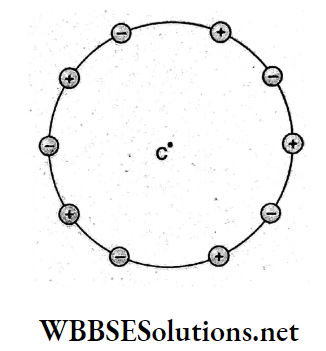Electrostatics
Question 1. Two identical charged spheres suspended from a common point by two massless strings of length l are initially a distance d (d << l) apart because of their mutual repulsion. The charges begin to leak from both spheres at a constant rate. As a result, the spheres approach each other with a velocity v. Then v varies with separation x between the spheres as
- v ∝ x-1/2
- v ∝ x-1
- v ∝ x1/2
- v ∝ x
Answer: 1. v α x-1/2
Resolving the tension T along the horizontal and vertical directions and equating the component forces,
⇒ \(T \sin \theta=F=\frac{K q^2}{x^2}\)…..(1)
and Tcosθ = mg…..(2)
Dividing (1) by (2),
⇒ \(\tan \theta=\frac{K q^2}{m g x^2}\)
For θ → 0, tan 0 → sin θ = \(\frac{x / 2}{l}\)
⇒ \(\frac{x}{2 l}=\frac{K q^2}{m g x^2}\)
⇒ \(x^3=\frac{K \cdot 2 l}{m g} q^2\)
⇒ \(q^2=\frac{m g}{2 k l} x^3=\text { constant } x^3\)
=> q = constant x3/2.
Differentiating w.r.t time t,
⇒ \(\frac{d q}{d t}=\text { constant } \frac{3}{2} x^{1 / 2} \cdot \frac{d x}{d t}\)
∵ \(\frac{d q}{d t}\) is constant, x-1/2 . v = constant
=> v ∝ x-1/2
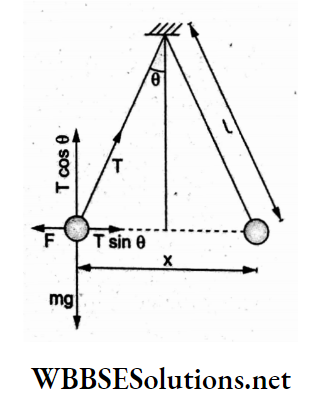
Question 2. Two pith balls carrying equal charges are suspended from a common point by strings of equal length, the equilibrium separation between them being r. Now, if the strings are rigidly clamped at half the height, the equilibrium separation r’ between the balls becomes
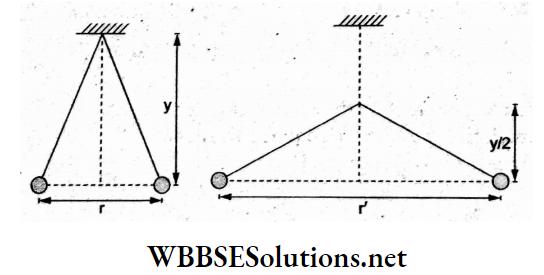
- \(\frac{2 r}{\sqrt{3}}\)
- \(\frac{2 r}{3}\)
- \(\frac{r}{\sqrt{2}}\)
- \(\frac{r}{\sqrt[3]{2}}\)
Answer: 4. \(\frac{r}{\sqrt[3]{2}}\)
In the first case, let θ be the deflection of the string and r be the separation between the balls, so
⇒ \(T \sin \theta=F=K \frac{q^2}{r^2}\)
and Tcosθ = mg.
∴ \(\frac{r / 2}{y}=\frac{K q^2}{m g r^2}\)……..(1)
Similarly, in the 2nd case,
⇒ \(\tan \theta^{\prime}=\frac{r^{\prime} / 2}{y / 2}=\frac{K q^2}{m g r^{\prime 2}}\)
Dividing (2) by (1), \(\frac{2 r^{\prime}}{r}=\frac{r^2}{r^{\prime 2}}\)
⇒ \(r^3=\frac{1}{2} r^3\)
⇒ \(r^{\prime}=\frac{r}{\sqrt[3]{2}}\)
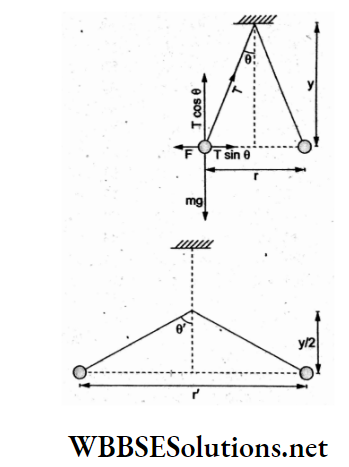
Question 3. Two positive ions, each having a charge q, are separated by a distance d. If F is the force of repulsion between the ions, the number of electrons missing from each ion will be (e = charge on the electron)
- \(\frac{4 \pi \varepsilon_0 F d^2}{e^2}\)
- \(\sqrt{\frac{4 \pi \varepsilon_0 e^2}{d^2}}\)
- \(\sqrt{\frac{4 \pi \varepsilon_0 F d^2}{e^2}}\)
- \(\frac{4 \pi \varepsilon_0 e^2}{F d^2}\)
Answer: 3. \(\sqrt{\frac{4 \pi \varepsilon_0 F d^2}{e^2}}\)
Let q = Ne, where N is the number of missing electrons.
From Coulomb’s law,
⇒ \(F=\frac{1}{4 \pi \varepsilon_0} \frac{q^2}{d^2}\)
⇒ \(q=N e=\sqrt{4 \pi \varepsilon_0 F d^2}\)
⇒ \(N=\sqrt{\frac{4 \pi \varepsilon_0 F d^2}{e^2}} .\)
Question 4. The electric field at a distance \(\frac{3R}{2}\) from the center of a charged conducting spherical shell of radius JR is E. The electric field at a distance \(\frac{R}{2}\) from the centre of the sphere is
- E
- \(\frac{E}{2}\)
- \(\frac{E}{3}\)
- Zero
Answer: 4. Zero
The electric field due to a spherical conducting shell of radius R is given by
⇒ \(E=\frac{1}{4 \pi \varepsilon_0} \frac{Q}{r^2} \text { for } r>R \text { and } E=0 \text { for } r<R\)
In this case, since r = \(\frac{R}{2}\) , the value of the field \(\vec{E}\) is zero.
Question 5. A thin conducting ring of radius R is given a charge +Q. The electric field at the center O of the ring due to the charge on the part AKB of the ring is E. The electric field at the center due to the charge on the part ACDB of the ring is
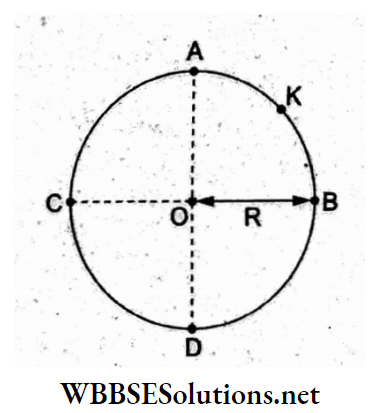
- E along KO
- 3E along OK
- 3E along OK
- E along OK
Answer: 4. E along OK
The field at the center O of the ring is zero. This is because the field at each quadrant will cancel out the field of the opposite quadrant. The field due to each quadrant is given as E.
Due to the part ACDB (consisting of three quadrants), the field due to parts AC and BD will cancel out and the net field will be due to part CD, which is E and directed along the bisector OK.
Question 6. The electric field at the centre O of semicircle of radius R having linear charge density yyy is given by
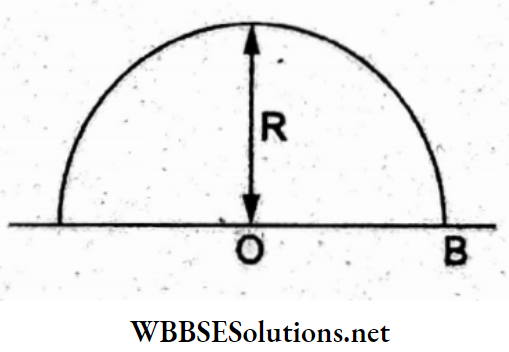
- \(\frac{2 \lambda}{\varepsilon_0 R}\)
- \(\frac{\pi \lambda}{\varepsilon_0 R}\)
- \(\frac{\lambda}{2 \pi \varepsilon_0 R}\)
- \(\frac{\lambda}{\pi \varepsilon_0 R}\)
Answer: 3. \(\frac{\lambda}{2 \pi \varepsilon_0 R}\)
Charge on the element AB of the ring is dq = XR dQ.
The field at the centre O due to this element,
⇒ \(d E=K \frac{d q}{R^2}=\frac{k \lambda R d \theta}{R^2}\)
This is directed radially along AO.
From considerations of symmetry, the x-components cancel out, and the net field is along the y-axis.
Thus, \(d E_y=d E \sin \theta=\frac{K \lambda R}{R^2} \sin \theta d \theta\)
Integrating,
⇒ \(E_y=\int d E_y=\frac{1}{4 \pi \varepsilon_0} \frac{\lambda}{R} \int_0^\pi \sin \theta d \theta=\frac{1}{4 \pi \varepsilon_0} \frac{\lambda}{R}[\cos \theta]_\pi^0=\frac{\lambda}{2 \pi \varepsilon_0 R}\)
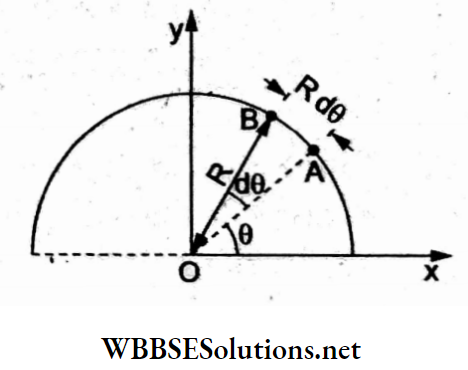
Question 7. A hollow insulated conducting sphere is given a positive charge of 10 μC. The electric field at the centre of the sphere, if its radius is 2 meters, will be
- 20 μCm-2
- 5 μCm-2
- Zero
- 8 μCm-2
Answer: 3. Zero
The electric field in the cavity of a hollow, charged conducting spherical shell is zero.
Question 8. A particle of mass m with charge q is placed at rest in a uniform electric field £ and then released. The kinetic energy gained by the particle after moving a distance y is
- qEy
- qE²y
- qEy²
- q2Ey
Answer: 1. qEy
Force on the charged particle = F = qE.
Work done by the electric field = Fy = qEy.
According to the work-energy theorem,
work done = change in \(\mathrm{KE}=\mathrm{KE}_{\text {final }}-\mathrm{KE}_{\text {initial }}\)
⇒ \(q E y=\frac{1}{2} m v^2\)
∴ KE gained = qEy
Question 9. The given figure represents electric field lines due to two charges q1 and q2. What are the signs of the two charges?
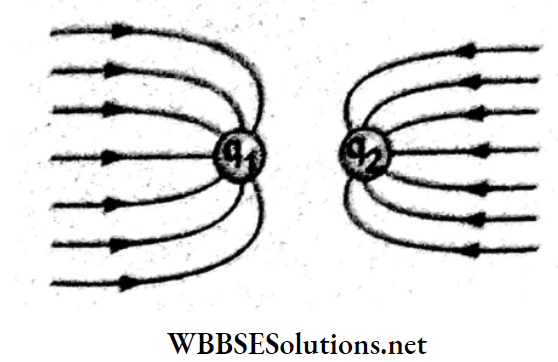
- q1 is positive but q2 is negative.
- q1 is negative but q2 is positive.
- Both are negative.
- Both are positive.
Answer: 3. Both are negative.
According to the convention, electric field lines emerge from positive charges and end at negative charges. In the given figure, the field lines end at both q1 and q2. Hence both q1 and q2 are negative charges.
Question 10. An electron is moving around the nucleus of a hydrogen atom in a circular orbit of radius r. The Coulomb force F between the two is
- \(K \frac{e^2}{r^3} \vec{r}\)
- \(-K \frac{e^2}{r^3} \vec{r}\)
- \(K \frac{e^2}{r^2} \hat{r}\)
- \(-K \frac{e^2}{r^3} \hat{r}\)
Answer: 2. \(-K \frac{e^2}{r^3} \vec{r}\)
The force of attraction between the proton and electron has magnitude \(F=\frac{K e^2}{r^2}\) and is directed along PO.
Taking O as the origin,
⇒ \(\vec{F}=-\frac{K e^2}{r^2} \hat{r}=-\frac{K e^2}{r^3} \vec{r}\)
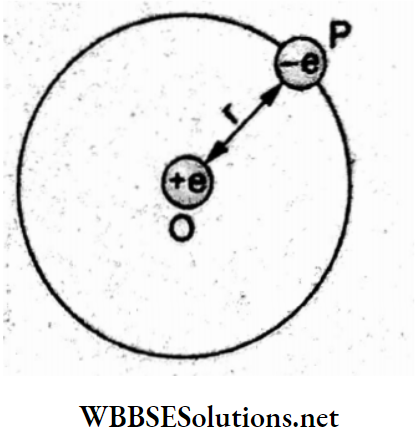
Question 11. A pendulum bob of mass 30.7 x 10-6 kg carrying a charge of 2 x 10-8 C is at rest in a horizontal uniform electric field of intensity 2 x 104 V m1. The tension in the thread of the pendulum is (g = 9.8 m s-2)
- 3 x 10-4 N
- 3 x 10-4 N
- 5 x 10-4 N
- 6 x 10-4 N
Answer: 3. 5 x 10-4 N
Forces acting on the bob are (1) weight mg, (2) force due to electric field (\(\vec{E}\)) qE, and (3) tension T. For the system to be in equilibrium
⇒ \(T=\sqrt{(m g)^2+(q E)^2}\)
⇒ \(\sqrt{\left(30.7 \times 10^{-6} \times 10\right)^2+\left(2 \times 10^{-8} \times 2 \times 10^4\right)^2}\)
⇒ \(\sqrt{\left(3 \times 10^{-4}\right)^2+\left(4 \times 10^{-4}\right)^2}=5 \times 10^{-4} \mathrm{~N}\)
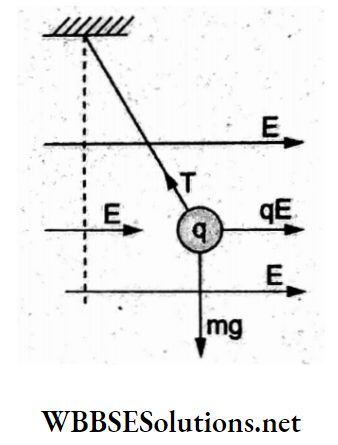
Question 12. According to an early model, an atom was considered to have a positively charged point nucleus of charge Ze, surrounded by a uniform density of negative charge up to a radius R. The atom as a whole was considered neutral even then. The electric field at a distance r(r<R) from the nucleus would then be
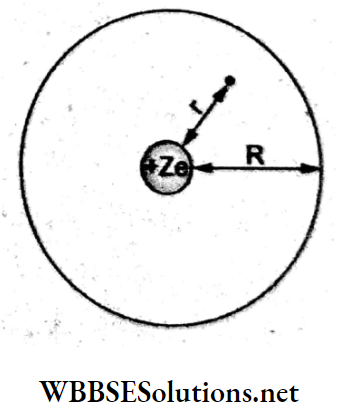
- \(\frac{Z e}{4 \pi \varepsilon_0}\left(\frac{1}{r^2}-\frac{r}{R^3}\right)\)
- \(\frac{1}{4 \pi \varepsilon_0}\left(\frac{1}{r^3}-\frac{r}{R^2}\right)\)
- \(\frac{\mathrm{Ze}}{4 \pi \varepsilon_0}\left(\frac{r}{R^3}-\frac{1}{r^2}\right)\)
- \(\frac{1}{4 \pi \varepsilon_0}\left(\frac{r}{R^3}+\frac{1}{r^2}\right)\)
Answer: 1. \(\frac{Z e}{4 \pi \varepsilon_0}\left(\frac{1}{r^2}-\frac{r}{R^3}\right)\)
Since the atom as a whole is neutral, the negative charge (-Ze) is uniformly distributed within the radius R of a sphere concentric with a tire nucleus.
Thus, the charge density is
⇒ \(\rho=\frac{(-Z e)}{\frac{4}{3} \pi R^3}=-\frac{3}{4 \pi} \frac{Z e}{R^3}\)
The negative charge enclosed within a sphere of radius r is
⇒ \(Q^{\prime}=-\frac{3}{4 \pi} \frac{Z e}{R^3} \cdot \frac{4}{3} \pi r^3=-\frac{Z e r^3}{R^3}\)
The net charge enclosed in this sphere is
⇒ \(Q_i=Q^{\prime}+Z e=Z e\left(1-\frac{r^3}{R^3}\right)\)
Applying Gauss’s theorem, electric flux = \(E A=\frac{1}{\varepsilon_0} Q_i\)
⇒ \(E \cdot 4 \pi r^2=\frac{1}{\varepsilon_0} Z e\left(1-\frac{r^3}{R^3}\right)\)
⇒ \(E=\frac{Z e}{4 \pi \varepsilon_0}\left(\frac{1}{r^2}-\frac{r}{R^3}\right)\)
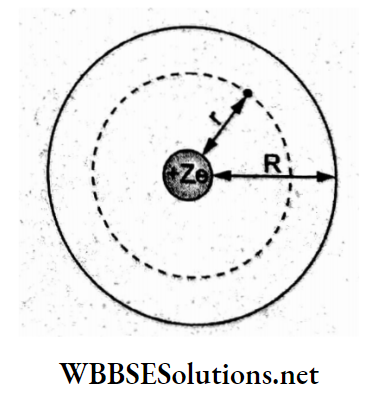
Question 13. The electric field strength (or dielectric strength) of dry air at stp is 3 x 106 V m-1. The maximum charge that can be given to a spherical conductor of radius 3 m is
- 3 x 10-4 C
- 3 x 10-4 C
- 3 x 10-2 C
- 0.3 C
Answer: 2. 3 x 10-3 C
Dielectric strength is the maximum electric field that the dielectric can sustain without breaking down.
Given, \(E_{\max }=3 \times 10^6 \mathrm{Vm}^{-1}=\frac{1}{4 \pi \varepsilon_0} \frac{Q}{R^2}\)
∴ Q = 4πE0R² (3 x 106 V m-1)
⇒ \(\frac{1}{9 \times 10^9}(3 \mathrm{~m})^2\left(3 \times 10^6 \mathrm{Vm}^{-1}\right)\)
= 3 x 10-3 C.
Question 14. A charge Q is enclosed by a Gaussian spherical surface of radius R. If the radius is doubled, the outward electric flux will
- Be reduced to half
- Remain the same
- Be doubled
- Increase four times
Answer: 2. Remain the same
The electric flux through a closed spherical surface is \(\phi=\frac{Q}{\varepsilon_0}\), where Q is the charge enclosed. The flux is independent of the radius of the spherical surface.
Hence, a change in the radius will not affect the value of the flux
Question 15. In a square, the plane surface of the paper side is L placed(in m) in a uniform electric field E (in V m-1) acting along the same plane L at an angle θ with the horizontal side of the square as shown. The electric flux linked to the surface in the unit of V m is
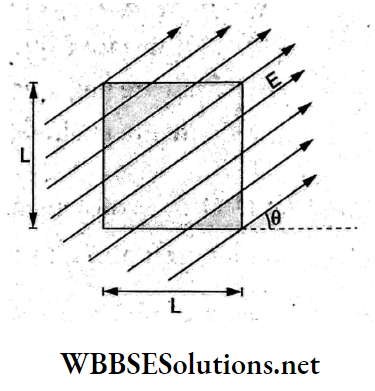
- EL²
- EL² cosθ
- EL² sinθ
- Zero
Answer: 4. Zero
In a uniform electric field, the flux of the electric field linked with a surface is \(\phi=\vec{E} \cdot \vec{A}\). The area vector is normal to the surface area, so the
angle between \(\vec{E}\) and \(\vec{A}\) is 90°.
Hence Φ = EA cos 90°
= 0.
Question 16. A hollow cylinder has a charge q coulomb within it. If is the electric flux in units of voltmetres associatedwiththecurvedsurface B, the flux linked with the plane surface A in volt metres will be
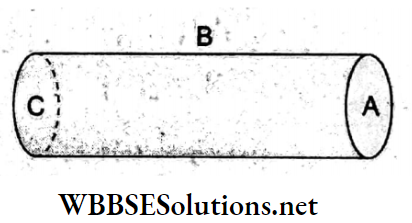
- \(\frac{1}{2}\left(\frac{q}{\varepsilon_0}-\phi\right)\)
- \(\frac{q}{2 \varepsilon_0}\)
- \(\frac{\phi}{\varepsilon_0}\)
- \(\frac{q}{\varepsilon_0}-\phi\)
Answer: 1. \(\frac{1}{2}\left(\frac{q}{\varepsilon_0}-\phi\right)\)
The total electric flux through the cylinder is linked partly through the curved surface (=Φ ) and partly through two plane faces (2Φp)
According to Gauss’s theorem,
total flux = \(\phi+2 \phi_{\mathrm{p}}=\frac{q}{\varepsilon_0}\)
⇒ \(\phi_{\mathrm{p}}=\frac{1}{2}\left(\frac{q}{\varepsilon_0}-\phi\right)\)
Question 17. A square surface of a side L meter is in the plane of the paper. A uniform electric field E (in V m-1) also in the plane of the paper is limited only to the lower half of the square surface (see figure). The electric flux in SI units linked With the surface is
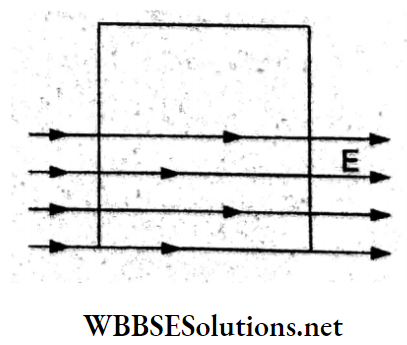
- \(\frac{E L^2}{2 \varepsilon_0}\)
- \(\frac{E L^2}{2}\)
- Zero
- EL²
Answer: 3. Zero
The area vector is directed perpendicular to the plane of the square
surface, so the angle between \(\vec{E}\) and \(\vec{A}\) is 90°.
Hence, \(\phi=\left(\frac{A}{2}\right)(E) \cos 90^{\circ}=0\)
Question 18. A charge q is situated at the center of a cube. The electric flux through any face of the cube is
- \(\frac{\pi q}{4 \pi \varepsilon_0}\)
- \(\frac{q}{6\left(4 \pi \varepsilon_0\right)}\)
- \(\frac{2 \pi q}{6\left(4 \pi \varepsilon_0\right)}\)
- \(\frac{4 \pi q}{6\left(4 \pi \varepsilon_0\right)}\)
Answer: 4. \(\frac{4 \pi q}{6\left(4 \pi \varepsilon_0\right)}\)
When the charge is at the center of a cube, its position is symmetrical.
The flux linked with each of the six faces will be equal. Hence, the electric flux through any face is
⇒ \(\phi_0=\frac{1}{6}(\text { total flux })=\frac{1}{6}\left(\frac{q}{\varepsilon_0}\right)=\frac{4 \pi q}{6\left(4 \pi \varepsilon_0\right)}\)
Question 19. Suppose the charge of a proton differs slightly from that of an electron. One of them is -e, and the other is (e + Δe). If the net of electrostatic force and gravitational force between two hydrogen atoms placed a distance d (much greater than atomic size) apart is zero then Ae is of the order of (given that mH = 1.67 x 10-27 kg)
- 10-23 C
- 10-37 C
- 10-47 C
- 10-20 C
Answer: 2. 10-37 C
The net charge on one H atom is cj = (-e) + (e + Δe) = Δe.
The repulsive force between two H atoms is Fe = \(F_{\mathrm{e}}=\frac{K q^2}{d^2}=\frac{K(\Delta e)^2}{d^2}\) .
The gravitational attractive force between two H atoms is
⇒ \(F_{\mathrm{g}}=\frac{G m_{\mathrm{H}}^2}{d^2}\)
Given that Fnet = 0, we have
⇒ \(F_{\mathrm{g}}=F_{\mathrm{e}}\)
⇒ \(\frac{K(\Delta e)^2}{d^2}=\frac{G m_{\mathrm{H}}^2}{d^2}\)
⇒ \(\Delta e=\sqrt{\frac{G m_{\mathrm{H}}^2}{K}}\)
= \(m_{\mathrm{H}} \sqrt{\frac{G}{K}}\)
= \(\left(1.6 \times 10^{-27}\right) \sqrt{\frac{\left(6.67 \times 10^{-11}\right)}{9 \times 10^9}}\)
=1.38 x 10-37C ≈ 10-37C
Question 20. The accompanying figure shows a S distribution of charges. The flux of the electric field due to these charges through the closed surface S is
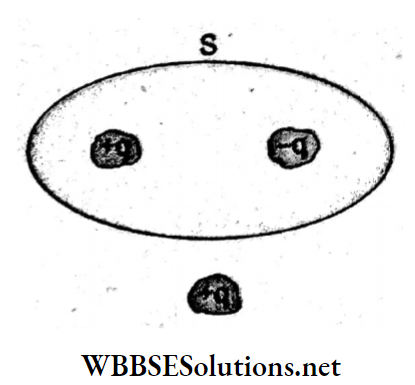
- \(\frac{3 q}{\varepsilon_0}\)
- \(\frac{2 q}{\varepsilon_0}\)
- \(\frac{q}{\varepsilon_0}\)
- Zero
Answer: 4. Zero
The total flux through a dosed surface is \(\phi=\frac{1}{\varepsilon_0}\) (total net charge enclosed).
In the given case, the outer charge +q does not contribute to the electric flux while the net charge enclosed is zero. Hence, the net flux is zero.
Question 21. The electric field in a certain region is acting radially outward and is given by E = At. A charge contained in a sphere of radius centered at the origin of the field will be given by
- 4πε0Aa³
- ε0Aa³
- 4πε0Aa²
- Aε0a²
Answer: 1. 4πε0Aa³
The electric field at the surface of the sphere of radius a is Aa, radially directed from the center O.
The total electric flux through the sphere = Φ = 4πa².E = 4πa² (Aa).
If q is the charge enclosed then according to Gauss’s law,
⇒ \(\phi=\frac{q}{\varepsilon_0}\)
\(q=\phi \varepsilon_0\)= \(4 \pi \varepsilon_0\left(A a^3\right)\)
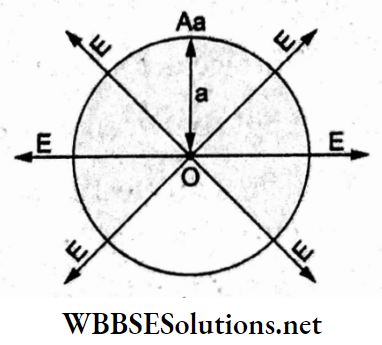
Question 22. A charge q is placed at the center of the line joining two equal charges Q. The system of the three charges will be in equilibrium if q is equal to
- –\(\frac{Q}{4}\)
- \(\frac{Q}{4}\)
- –\(\frac{Q}{2}\)
- \(\frac{Q}{2}\)
Answer: 1. –\(\frac{Q}{4}\)
The charge q is symmetrically placed between two equal charges +Q placed at A and B. Hence, for any value of q, the force on q will be zero. The system is in equilibrium, meaning each Q must experience zero net force.
So, \(F_{\text {net }}=K \frac{Q q}{(r / 2)^2}+K \frac{Q^2}{r^2}=0 \Rightarrow q=-\frac{Q}{4}\)
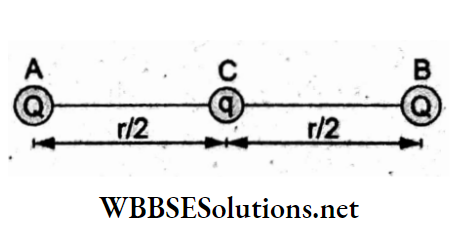
Question 23. Three charges are placed at the vertices of an equilateral triangle of side a as shown in the figure. The force experienced by the charge placed at the vertex A in a direction normal to BC is
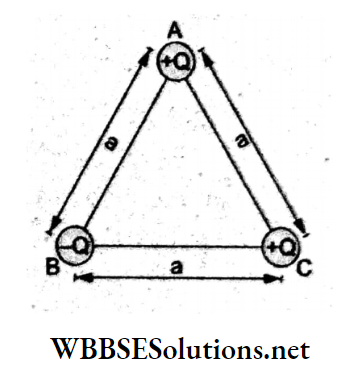
- \(\frac{Q^2}{4 \pi \varepsilon_0 a^2}\)
- -Q²(4πε0a²)
- Zero
- \(\frac{Q^2}{4 \pi \varepsilon_0 a^2}\)
Answer: 3. Zero
The force on +Q at A due to +Q at C is
⇒ \(f_1=\frac{K Q^2}{a^2}\) along CA,
and that due to -Q at B is
⇒ \(f_2=\frac{K Q^2}{a^2}\) along AB
These are equal in magnitudes (f1 = f2) and inclined at an angle of 120°.
Their net force F makes an angle of 60° with f1 as well as f2.
Since the direction of \(\vec{F}\) is parallel to BC, its component normal to BC will be zero.
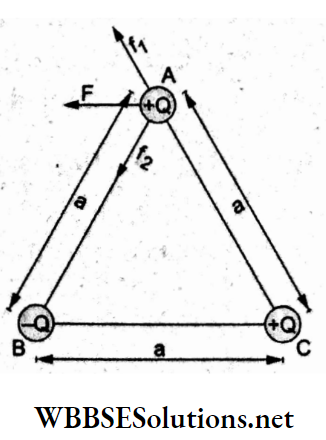
Question 24. The variation of electric field due to a uniformly charged conducting solid sphere of radius Rasa function of distance r from its centre is graphically represented by
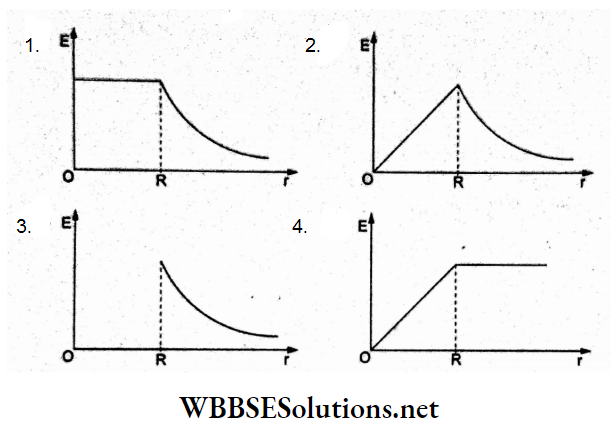
Answer: 2.
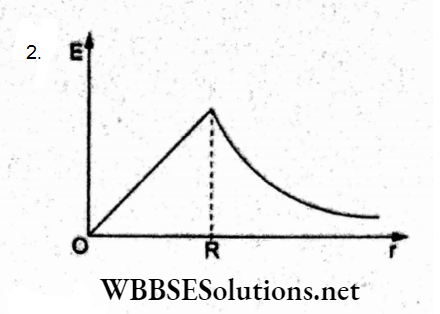
When charge Q is uniformly distributed throughout the volume of a solid sphere of radius R, the electric field inside the sphere at a distance r(r<R) from its center is \(E(r)=\frac{1}{4 \pi \varepsilon_0} \frac{Q}{R^3} r\), so E ∝ r, which represents a straight line through the origin.
For a point outside, \(E=\frac{1}{4 \pi \varepsilon_0} \frac{Q}{r^2}\) which means E decreases nonlinearly with r.
This represents the graph (b).
Question 25. A charge q is uniformly distributed on a ring of radius R. A sphere of an equal radius is constructed with its centre lying on the periphery of the ring. The flux of the electric field through the surface of the sphere will be
- \(\frac{q}{\varepsilon_0}\)
- \(\frac{q}{2 \varepsilon_0}\)
- \(\frac{q}{3 \varepsilon_0}\)
- \(\frac{q}{4 \varepsilon_0}\)
Answer: 3. \(\frac{q}{3 \varepsilon_0}\)
From the figure,
OA = radius of the ring,
O’A = radius of the sphere, and
OO’ = distance between their centers.
Since OA = O’A = OO’ = JR, ΔAOO’ is equilateral.
∴ \(\angle A O B=120^{\circ}=\frac{2 \pi}{3}\)
Arc AO’B of the ring enclosed within the sphere is \(R\left(\frac{2 \pi}{3}\right)\) contains the charge \(\frac{q}{2 \pi R} \cdot R \cdot \frac{2 \pi}{3}=\frac{q}{3}\) the flux of the electric field through the sphere is
⇒ \(\phi=\frac{1}{\varepsilon_0}\left(\frac{q}{3}\right)=\left(\frac{q}{3 \varepsilon_0}\right)\)
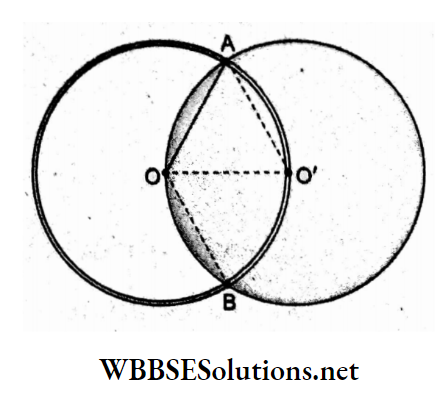
Question 26. Four charges are arranged at the corners of a square as shown in the figure. The direction of the electric field at the centre of the square will be along
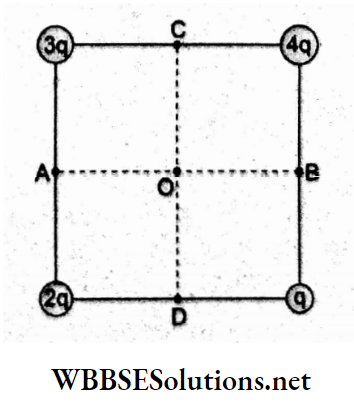
- CD
- BC
- AD
- AB
Answer: 1. CD
The field at a point is the force per unit test charge (+ve).
The field at the centre O due to charges 3q and q at the opposite comers is
⇒ \(E_1=K \frac{2 q}{r^2}\),directed along OG.
Similarly, the field at O due to the pair of charges 4q and 2q is
⇒ \(E_2=K \frac{2 q}{r^2}\), directed along OF.
The fields E1 and E2 are equal in magnitude so that the net field will be along CD.
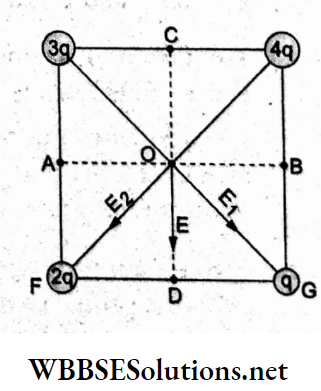
Question 27. The electric field due to a charged straight conductor outside will be proportional to the distance r as
- \(\frac{1}{r}\)
- \(\frac{1}{r^2}\)
- \(\frac{1}{r^{3 / 5}}\)
- \(\frac{1}{r^{3 / 2}}\)
Answer: 1. \(\frac{1}{r}\)
In order to find the electric field due to a straight-charged conductor, we consider a coaxial cylindrical surface and apply Gauss’s theorem.
∴ \(E 2 \pi r l=\frac{\lambda l}{\varepsilon_0} \Rightarrow E=\frac{\lambda}{2 \pi \varepsilon_0 r}\)
Hence, H oc \(\frac{1}{r}\)
Question 28. An electron is projected with velocity \(\vec{v}=v_0 \hat{i}\) in the electric’ field \(\vec{E}=E_0 \hat{j}\). The path followed by the electron is a
- Parabola
- Circle
- Straight line in the positive y-direction
- Straight line in the negative y-direction
Answer: 1. Parabola
The motion of the title electron is along the and the force is along the negative y-direction as die field is along the y-direction. At t = 0, let the electron be at the origin. At time t,
⇒ \(x=v_0 t \text { and } y=\frac{1}{2} a t^2=\frac{1}{2}\left(\frac{e E}{m}\right)\left(\frac{x}{v_0}\right)^2\)
∴ \(y=\frac{1}{2}\left(\frac{e E}{m v_0^2}\right) x^2=k x^2\)
Question 29. The electric field at a distance r from an infinitely long uniformly charged conducting sheet is
- Proportional to r-1
- Proportional to r-2
- Proportional to r-3/2
- Independent of r
Answer: 4. Independent of r
According to Gauss’s theorem, the total outward flux is
⇒ \(E=\Delta S+E \Delta S=\frac{1}{\varepsilon_0}(\sigma \Delta S)\)
where σ = surface charge density.
∴ \(E=\frac{\sigma}{2 \varepsilon_0}\)
which is independent of distance r.
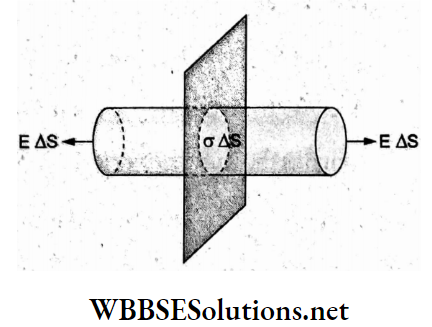
Question 30. A solid conducting sphere is placed in a uniform electric field. Which path correctly 2 indicates the electric field lines in the given diagram?
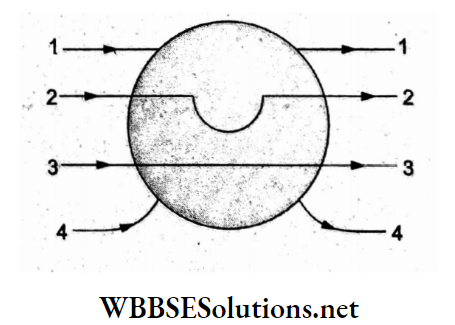
- 1
- 2
- 3
- 4
Answer: 4. 4
The surface of a conductor is equipotential, where the direction of the electric field lines is always perpendicular to the surface.
For a sphere, the normal direction is radial (directed towards the center) and hence the field lines terminate radially on the left side and restart radially from the right side, as shown by line 4.
Question 31. Three identical charges, each equal to q, are placed at the vertices of an equilateral triangle of side a. The magnitude of the force experienced by each charge is
- \(\frac{1}{4 \pi \varepsilon_0} \frac{2 q^2}{a^2}\)
- \(\frac{1}{4 \pi \varepsilon_0} \frac{q^2}{2 a^2}\)
- \(\frac{1}{4 \pi \varepsilon_0} \frac{\sqrt{3} q^2}{a^2}\)
- \(\frac{1}{4 \pi \varepsilon_0} \frac{q^2}{\sqrt{2} a^2}\)
Answer: 3. \(\frac{1}{4 \pi \varepsilon_0} \frac{\sqrt{3} q^2}{a^2}\)
Forces acting on charge cj at A due to the remaining equal charges are
⇒ \(f=f_1=f_2=\frac{1}{4 \pi \varepsilon_0} \frac{q}{a^2}\)
∴ the magnitude of the net force is
⇒ \(F_{\text {net }}=\sqrt{f_1^2+f_2^2+2 f_1 f_2 \cos 60^{\circ}}\)
⇒ \(\sqrt{2 f^2+2 f^2 \times \frac{1}{2}}\)
= \(\sqrt{3} f\)
= \(\frac{1}{4 \pi \varepsilon_0} \frac{\sqrt{3} q^2}{a^2}\)
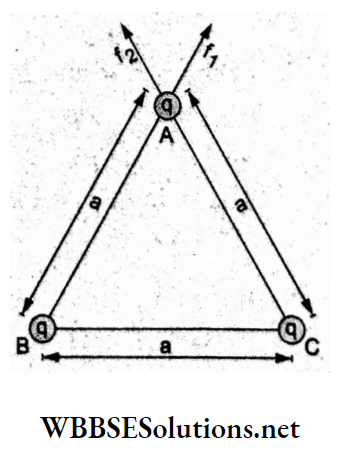
Question 32. An electric dipole is placed at an angle of 30° with an electric field of intensity 2 x 105 N C-1. It experiences a torque equal to 4 N m. The charge on the dipole, if the dipole length is 2 cm, is
- 8 mC
- 2 mC
- 5 mC
- 7 μC
Answer: 2. 2mC
Given that electric field = = 2 x 105 NC-1, 0 = 30°,E torque = \(\tau\) = 4 N m, dipole length = 2l = 2 x 10-2 m.
⇒ \(\tau=p E \sin \theta\)
∴ \(p=q 2 l=\frac{\tau}{E \sin \theta}\)
or, \(q=\frac{\tau}{E(2 l) \sin \theta}\)
Substituting the values,
⇒ \(q=\frac{4 \mathrm{~N} \mathrm{~m}}{\left(2 \times 10^5 \mathrm{~N} \mathrm{C}^{-1}\right)\left(2 \times 10^{-2} \mathrm{~m}\right)(0.5)}\)
= 2 x 10-3C
= 2mC.
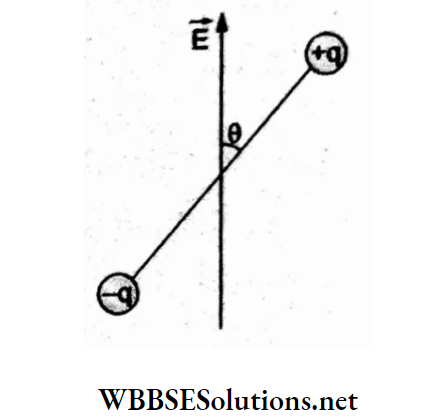
Question 33. The potential (in volts) in a region is expressed as V(x, y, z) = 6xy- y + 2yz. The electric field (in N C-1) at point (1,1, 0) is
- \(-(2 \hat{i}+3 \hat{j}+\hat{k})\)
- \(-(6 \hat{i}+9 \hat{j}+\hat{k})\)
- \(-(3 \hat{i}+5 \hat{j}+3 \hat{k})\)
- \(-(6 \hat{i}+5 \hat{j}+2 \hat{k})\)
Answer: 4. \(-(6 \hat{i}+5 \hat{j}+2 \hat{k})\)
Given that the potential is a function of x, y, z, i.e.,
V(x,y,z) = 6xy – y + 2yz.
The electric field along the x-direction is
⇒ \(E_x=-\frac{\delta V}{\delta x}=-6 y\)
Similarly, \({E_y}=-\frac{\delta V}{\delta y}=-6 x+1-2 z\)
⇒ \(E_z=-\frac{\delta V}{\delta z}=-2 y\)
At point (1,1,0) \(\vec{E}_x=-6 \hat{i}, \vec{E}_y=-5 \hat{j} \text { and } \vec{E}_z=-2 \hat{k}\)
Thus, \(\vec{E}=-(6 \hat{i}+5 \hat{j}+2 \hat{k})\)
Question 34. In a region, the potential is represented as V(x, y, z) = 6x – 8xy – 8y + 6yz, where Vis in volts and x, y, z are in meters. The electric force experienced by a charge of 2 coulombs situated at point (1,1, 1) is
- 6√5 N
- 30 N
- 24 N
- \(4 \sqrt{35} \mathrm{~N}\)
Answer: 4. \(4 \sqrt{35} \mathrm{~N}\)
Potential = V = 6x – 8xy – 8y + 6yz.
∴ \(E_x=-\frac{\partial V}{\partial x}=-6+8 y\)
⇒ \(E_y=-\frac{\partial V}{\partial y}=8 x+8-6 z, \text { and }\)
⇒ \(E_z=-\frac{\partial V}{\partial z}=-6 y\)
At point (1, 1,1), \(\vec{E}=2 \hat{i}+10 \hat{j}-6 \hat{k}\)
The magnitude of the electric field is,
⇒ \(|\vec{E}|=\sqrt{2^2+10^2+(-6)^2} \mathrm{Vm}^{-1}\)
= \(2 \sqrt{35} \mathrm{Vm}^{-1}\)
∴ the force on the charge Q = 2C is
F = QE
= \((2 \mathrm{C})\left(2 \sqrt{35} \mathrm{Vm}^{-1}\right)\)
= \(4 \sqrt{35} \mathrm{~N}\)
Question 35. An electric dipole of dipole moment \(\vec{p}\) is aligned parallel to a uniform electric field \(\vec{E}\). The energy required to rotate the dipole by 90° is
- p²E
- pE
- pE²
- Infinite
Answer: 2. pE
The energy required to rotate the dipole from θ = 0 to θ is
W = pE(1-cosθ).
Here θ = 90°, so die energy required is W = pE
Question 36. A cube of side 10 cm has charge Q at each of its eight comers. If the potential at the center of the cube is 144 x 104 V, the charge Q in coulombs is
- √2 μC
- √3 μC
- 2 μC
- 3μC
Answer: 2. √3 μC
The distance of each comer of the cube from the centre is \(r=\frac{\sqrt{3}}{2} a\)
Hence, the total potential at the centre is
⇒ \(V=\frac{1}{4 \pi \varepsilon_0} \frac{8 Q}{r}=\left(9 \times 10^9\right) \frac{8 Q}{\left(\frac{\sqrt{3}}{2} a\right)}\)
⇒ \(Q=\left(\frac{\sqrt{3}}{2} a\right) \frac{V}{8\left(9 \times 10^9\right)} \mathrm{C}\)
⇒ \(\frac{\sqrt{3}}{2} \frac{\left(10 \times 10^{-2}\right)\left(144 \times 10^4\right)}{72 \times 10^9} \mathrm{C}\)
√3 x 10-6C
= √3μC.
Question 37. A straight wire of length L has charge Q distributed uniformly along its length. If the wire is bent into a semicircular shape, the potential at the centre of curvature of the semicircle is
- \(\frac{Q}{L}\)
- \(\frac{Q}{\varepsilon_0 L}\)
- \(\frac{Q}{4 \pi \varepsilon_0 L}\)
- \(\frac{Q}{4 \varepsilon_0 L}\)
Answer: 4. \(\frac{Q}{4 \varepsilon_0 L}\)
Given that length = L = πR, where R is the radius of the semi circle.
∴ the potential at the centre is
⇒ \(V=\frac{1}{4 \pi \varepsilon_0} \frac{Q}{R}=\frac{1}{4 \pi \varepsilon_0} \frac{Q}{L / \pi}=\frac{Q}{4 \varepsilon_0 L}\)
Question 38. The electric potential at a point P(x, y, z) in space is expressed as V = A(xy + yz + zx), where A is a constant. The electric field at P will be
- \(-A(x \hat{i}+y \hat{j}+z \hat{k})\)
- \(-A[(x+y) \hat{i}+(y+z) \hat{j}+(z+x) \hat{k}]\)
- \(-A[(y+z) \hat{i}+(z+x) \hat{j}+(x+y) \hat{k}]\)
- \(\frac{A}{\sqrt{x^2+y^2+z^2}}(x \hat{i}+y \hat{j}+z \hat{k})\)
Answer: 3. \(-A[(y+z) \hat{i}+(z+x) \hat{j}+(x+y) \hat{k}]\)
Given that potential = V = A(xy + yz + zx).
⇒ \(E_x=-\frac{\partial V}{\partial x}=-A(y+z)\)
⇒ \(E_y=-\frac{\partial V}{\partial y}=-A(x+z)\)
⇒ \(E_z=-\frac{\partial V}{\partial z}=-A(x+y)\)
∴ \(\vec{E}=E_x \hat{i}+E_y \hat{j}+E_z \hat{k}\)
= \(-A[(y+z) \hat{i}+(x+z) \hat{j}+(x+y) \hat{k}]\)
Question 39. An electric dipole of moment p is placed in an electric field of intensity £. The dipole acquires a position such that its axis makes an angle 0 with the direction of the field. Assuming that the potential energy of the dipole to be zero when 0 = 90°, the torque and the potential energy of the dipole will respectively be
- pE sin θ and -pE cos θ
- pE sin θ and-2pE cos θ
- pE sin θ and 2pE cos θ
- pE cos θ and -pE sin θ
Answer: 1.
Torque on the dipole \(\vec{\tau}=\vec{p} \times \vec{E} . \text { So }|\vec{\tau}|=p E \sin \theta\)
Potential energy \(U=-\vec{p} \cdot \vec{E}=-p E \cos \theta\)
Question 40. Four point charges -Q,-q, 2q and 2Q are placed, one at each comer of a square. The relation between Q and q for which the potential at the centre of the square is zero will be
- Q = -q
- Q = –\(\frac{1}{q}\)
- Q = q
- Q = \(\frac{1}{q}\)
Answer: 1. Q = -q
Let the distance of each comer from the centre of the square = r.
∴ the net potential at the centre is,
⇒ \(V=\frac{1}{4 \pi \varepsilon_0}\left(\frac{-Q}{r}+\frac{-q}{r}+\frac{2 q}{r}+\frac{2 Q}{r}\right)\)
⇒ \(\frac{1}{4 \pi \varepsilon_0}\left(\frac{Q+q}{r}\right)\)
∵ V = 0,Q + q = 0
=> Q = -q.
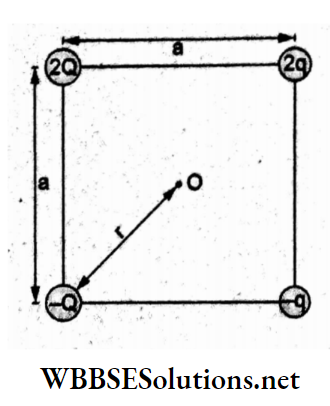
Question 41. Four electric charges +q, +q, -q, -q are placed at the comers of a square of side 2L. The electric potential at A, midway between the two charges +q and +q, is
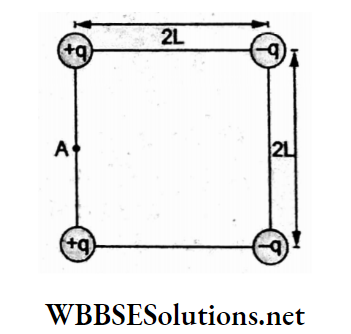
- \(\frac{1}{4 \pi \varepsilon_0} \frac{2 q}{L}(1+\sqrt{5})\)
- \(\frac{1}{4 \pi \varepsilon_0} \frac{2 q}{L}\left(1+\frac{1}{\sqrt{5}}\right)\)
- \(\frac{1}{4 \pi \varepsilon_0} \frac{2 q}{L}\left(1-\frac{1}{\sqrt{5}}\right)\)
- Zero
Answer: 3. \(\frac{1}{4 \pi \varepsilon_0} \frac{2 q}{L}\left(1-\frac{1}{\sqrt{5}}\right)\)
Potential at A due to the pair of charges \((+q,+q) \text { is } V_1=\frac{1}{4 \pi \varepsilon_0} \frac{2 q}{L}\)
Distance of A from each-q charge = \(\sqrt{4 L^2+L^2}=\sqrt{5} L\)
∴ the potential at A due to the pair ofcharges \((-q,-q), V_2=\frac{1}{4 \pi \varepsilon_0} \frac{-2 q}{(\sqrt{5 L})}\)
∴ the total potential at A is \(V=V_1+V_2=\frac{1}{4 \pi \varepsilon_0} \frac{2 q}{L}\left(1-\frac{1}{\sqrt{5}}\right)\)
Question 42. Three charges, each +q, are placed at the comers of an equilateral triangle ABC of side 2a. D and E are the midpoints of BC and CA. The work done in taking a charge Q from D to
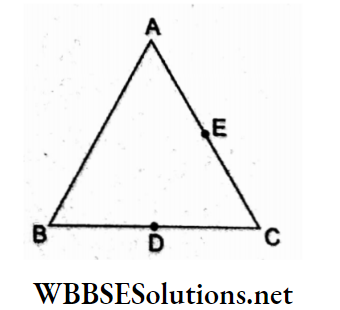
- \(\frac{3 Q q}{4 \pi \varepsilon_0 a}\)
- \(\frac{3 Q_q}{8 \pi \varepsilon_0 a}\)
- \(\frac{Q q}{4 \pi \varepsilon_0 a}\)
- Zero
Answer: 4. Zero
The potential at E due to the three charges is
⇒ \(V_{\mathrm{B}}=\frac{1}{4 \pi \varepsilon_0}\left(\frac{q}{a}+\frac{q}{a}+\frac{q}{\sqrt{3} a}\right)\)
⇒ \(\frac{1}{4 \pi \varepsilon_0} \frac{q}{a}\left(2+\frac{1}{\sqrt{3}}\right)\)
Similarly at D, \(V_{\mathrm{D}}=\frac{1}{4 \pi \varepsilon_0} q\left(2+\frac{1}{\sqrt{3}}\right)\)
∴ VD = VB, the work done is W = Q (VD – VE) = 0
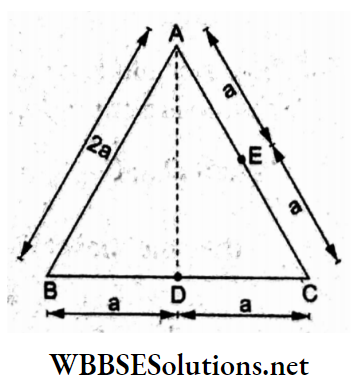
Question 43. The electric potential V at any point (x, y, z), all in meters, in space, is given by V = 4x² volts. The electric field of the point (1, 0, 2) in V m-1 is
- 8 along the negative x-axis
- 8 along the positive x-axis
- 16 along the negative x-axis
- 16 along the positive x-axis
Answer: 1. 8 along the negative x-axis
Given that V = 4x².
Electric field = \(E=-\frac{\partial V}{\partial x}=-8 x\)
For \(x=1, \vec{E}_x=-8 \mathrm{~V} \mathrm{~m}^{-1} \hat{i}\)
Hence, the field is 8 V m-1 along the negative x-axis.
Question 44. The electric potential at a point (x, y, z) is given by V = -x²y- xz³ + 4. The electric field at that point is
- \(\vec{E}=2 x y \hat{i}+\left(x^2+y^2\right) \hat{j}+\left(3 x z+y^2\right) \hat{k}\)
- \(\vec{E}=z^3 \hat{i}+x y z \hat{j}+z^2 \hat{k}\)
- \(\vec{E}=\left(2 x y-z^3\right) \hat{i}+x y^2 \hat{j}+3 x z^2 \hat{k}\)
- \(\vec{E}=\left(2 x y+z^3\right) \hat{i}+x^2 \hat{j}+3 x z^2 \hat{k}\)
Answer: 4. \(\vec{E}=\left(2 x y+z^3\right) \hat{i}+x^2 \hat{j}+3 x z^2 \hat{k}\)
Given that V = -x²y- xz³ + 4.
The electric field \(\vec{E}\) has the following components:
⇒ \(E_x=-\frac{\partial V}{\partial x}=+2 x y+z\)
⇒ \(E_y=-\frac{\partial V}{\partial y}=x^2\)
and \(E_z=-\frac{\partial V}{\partial z}=3 x z^2\)
∴ \(\vec{E}=E_x \hat{i}+E_y \hat{j}+E_z \hat{k}\)
= \(\left(2 x y+z^3\right) \hat{i}+x^2 \hat{j}+3 x z^2 \hat{k}\)
Question 45. The electric potential at a point in free space due to charge Q coulombs is Q x 1011 volts. The electric field at that point is
- 4πε0Q x 1020 V m-1
- 12πε0Q x 1022 V m-1
- 4πε0Q x 1022 V m-1
- 12πε0Q x 1020 V m-1
Answer: 3. 4πε0Q x 1022 V m-1
The electric potential due to a charge Q at a distance r is
⇒ \(V=K \frac{Q}{r}=Q \times 10^{11}\)….(1)
At the same point, the electric field
⇒ \(E=K \frac{Q}{r^2} \mathrm{~V} \cdot \mathrm{m}^{-1}\)….(2)
From (1),
⇒ \(\frac{K}{r}=10^{11}\)
⇒ \(r=\frac{K}{10^{11}}\)
From (2),
⇒\(E=\frac{K Q V m^{-1}}{\left(K / 10^{11}\right)^2}\)
= \(\frac{10^{22} Q}{K}\)
= \(4 \pi \varepsilon_0 Q \times 10^{22} \mathrm{Vm}^{-1}\)
Question 46. Charges +q and -q are placed at points A and B respectively, which are a distance 2L apart. C is the midpoint between A and B. The work done in moving a charge Q along the semicircle CRD is
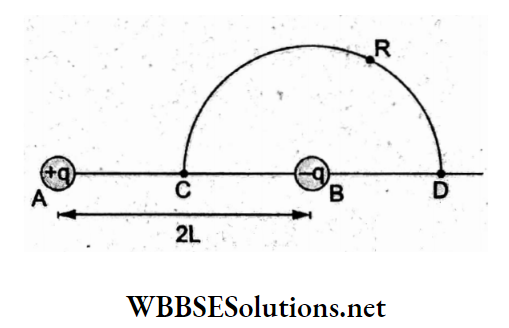
- \(\frac{Q q}{2 \pi \varepsilon_0 L}\)
- \(\frac{Q q}{6 \pi \varepsilon_0 L}\)
- –\(\frac{Q q}{6 \pi \varepsilon_0 L}\)
- \(\frac{Q q}{4 \pi \varepsilon_0 L}\)
Answer: 3. –\(\frac{Q q}{6 \pi \varepsilon_0 L}\)
The electric field is conservative, so the work done for the displacement of charge is path-independent.
Potential at \(\mathrm{C}=V_{\mathrm{C}}=\frac{K(+q)}{L}+\frac{K(-q)}{L}=0\)
∴ the potential at D,
⇒ \(V_{\mathrm{D}}=\frac{K(+q)}{3 L}+\frac{K(-q)}{L}=-\frac{2}{3} \frac{K q}{L}\)
∴ potential difference
⇒ \(\Delta V=V_D-V_C=\frac{-2}{3} \frac{K q}{L}\)
∴ work done \(W=Q \Delta V=\frac{-2}{3}\left(\frac{1}{4 \pi \varepsilon_0}\right) \frac{Q q}{L}=-\frac{Q q}{6 \pi \varepsilon_0 L}\)
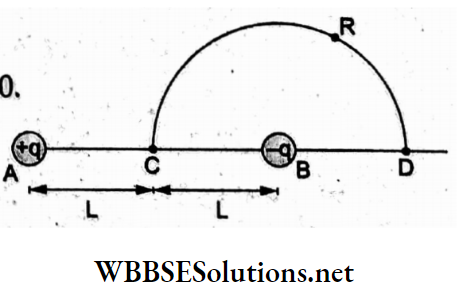
Question 47. Three point charges +q, -2q and +q are placed at points (x – 0, y =0a, z = 0), (x = 0, y = 0, z = 0) and (x = a, y = 0, z = 0) respectively. The magnitude and direction of the electric dipole moment vector of this charge assembly are
- √2qa along the line joining the points (x = 0, y = 0, z = 0) and
(x = a,y = a,z = 0) - qa along the line joining the points (x = 0, y = 0, z = 0) and
(x = a,y = q,z = 0) - √2qa along the positive r-direction
- √2qa along the positive y-direction
Answer: 1. √2qa along the line joining the points (x = 0, y = 0, z = 0) and
(x = a,y = a,z = 0)
The given system of charges constitutes yi two electric dipoles of the same magnitude (qa) directed along the x- and y-axes.
Thus, \(\vec{p}=(q a) \hat{i}+(q a) \hat{j}\)
The magnitude of the dipole moment is,
⇒ \(p=\sqrt{p_x^2+p_y^2}\)
= \(\sqrt{(q a)^2+(q a)^2}\)
= \(\sqrt{2} q a\)
Here \(\vec{p}\) makes an angle of 45° with the x-axis, and hence is along the line OP, where the coordinates of P are (a, a, 0)
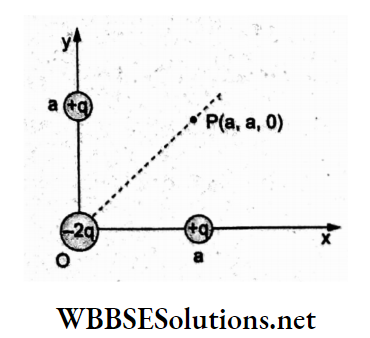
Question 48. As shown in the figure, a point charge +q is placed at the origin O. Work done in taking another charge -Q’from the point A(0, a) to another point B(a, 0) along the straight path AB is
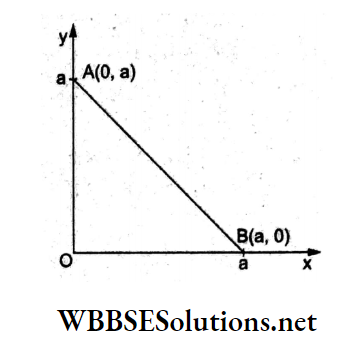
- Zero
- \(\left(\frac{Q q}{4 \pi \varepsilon_0 a^2}\right) \sqrt{2} a\)
- \(\left(\frac{-Q q}{4 \pi \varepsilon_0 a^2}\right) \sqrt{2} a\)
- \(\left(\frac{Q q}{4 \pi \varepsilon_0 a^2}\right) \frac{a}{\sqrt{2}}\)
Answer: 1. Zero
Points A and B are equidistant from the charge q at O, so the potential is
⇒ \(V_{\mathrm{A}}=V_{\mathrm{B}}=K \frac{Q}{a}\)
Work done = W = (-Q)(VB– VA)
= -Q x 0
= 0
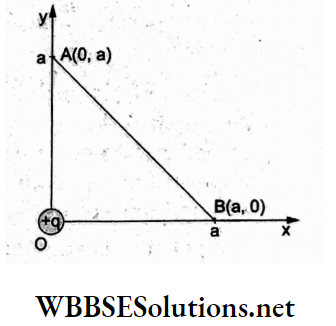
Question 49. A bullet of mass 2 g has a charge of 2 pC. Through what potential difference must it be accelerated, starting from rest, so as to acquire a speed of 10 m s-1?
- 5kV
- 50 kV
- 5 V
- 50 V
Answer: 2. 50 kV
Work done = change in KE
=> QV = KEfinal-KEinitial = \(\frac{1}{2}\) mv².
Given: Q = 2μC = 2 x 10-6C,
m = 2 g
= 2 x 10-3 kg,
v = 10 m s-1.
Potential difference = \(V=\frac{1}{2} \frac{m v^2}{Q}\)
⇒ \(\frac{1}{2} \frac{\left(2 \times 10^{-3} \mathrm{~kg}\right)\left(10 \mathrm{~m} \mathrm{~s}^{-1}\right)^2}{\left(2 \times 10^{-6} \mathrm{C}\right)}\)
= 50 x 103 V
= 50 kV.
Question 50. If Ea be the electric field due to an electric dipole on its axial line and Eq be the field on its equatorial line at the same distance r then the relation between Ea and Eq is
- Ea = Eq
- Ea = 2Eq
- Eq = 2E.
- Ea = 3Eq
Answer: 2. Ea = 2Eq
The magnitude of the electric field at the axial point is \(E_{\mathrm{ax}}=K\left(\frac{2 p}{r^3}\right)\)
and that at the equatorial point is \(E_{\text {eq }}=K\left(\frac{p}{r^3}\right)\)
Hence, the ratio is \(\frac{E_{\mathrm{ax}}}{E_{\mathrm{eq}}}=2 \Rightarrow E_{\mathrm{ax}}=2 E_{\mathrm{eq}}\)
Question 51. In a certain region of space, an electric field is along the positive z-direction throughout. The magnitude of the electric field, however, is not constant but increases uniformly along the positive z-direction at a constant rate of 105 N C-1 m-1. The force experienced by the system having a total dipole moment equal to 107 C m in the negative z-direction will be
- -10-2 N
- 10-2 N
- 10-4 N
- -10-4 N
Answer: 1. -10-2 N
In the given figure, the direction of the dipole moment p is along the negative z-direction and the field is increasing along the positive z-direction.
Force on the the charge +q is E+ = qE and that on charge (-q) is E_ = (-q)(E + AE)
⇒ \((-q)\left(E+\frac{d E}{d z} \cdot \Delta z\right)\)
∴ the net force on the dipole is,
⇒ \(F=q E-q E-q\left(\frac{d E}{d z} \cdot \Delta z\right)\)
⇒ \(-(q \Delta z) \frac{d E}{d z}\)
= \(-p\left(\frac{d E}{d z}\right)\)
= -(10-7 C m) (105 N C-1 m-1)
=-10-2 N.
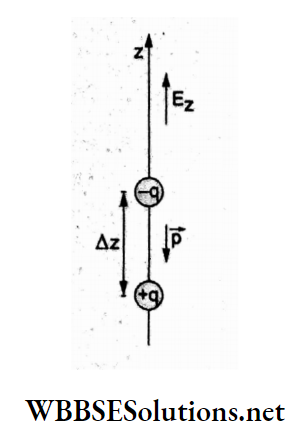
Question 52. The magnitude of the charge of an electric dipole is q and its dipole moment is p. The dipole is placed in a uniform electric field \(\vec{E}\). Its dipole moment vector \(\vec{p}\) is along the direction of the field \(\vec{E}\). The net force on it and its potential energy are respectively
- 2qE and minimum
- qE and pE
- qE and maximum
- Zero and minimum
Answer: 3. qE and maximum
An electric dipole consists of two, equal and opposite charges ±q and experiences equal and opposite forces. Hence, the net force on the dipole in a uniform electric field is zero. The potential energy of the dipole is,
⇒ \(U(\theta)=-\vec{p} \cdot \vec{E}=-p E \cos \theta\)
For θ = 0, U = -pE, which is minimum.
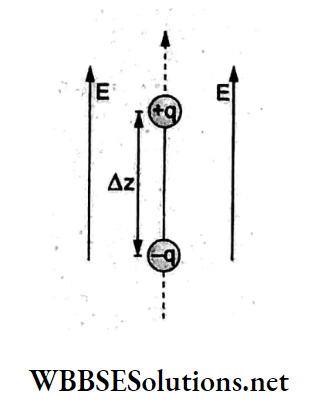
Question 53. Some charge is given to a conductor. Then it’s potential
- Is maximum at the surface
- Is maximum at the centre
- Remains the same throughout the conductor
- Is maximum somewhere between the surface and center
Answer: 3. Remains the same throughout the conductor
The surface of a charged conductor of any shape is equipotential and its potential remains the same throughout the conductor as \(\vec{E}\) = 0 inside.
Question 54. If a dipole of dipole moment \(\vec{p}\) is placed in a uniform electric field \(\vec{E}\) then die torque acting on it is given by
- \(\vec{\tau}=\vec{p} \cdot \vec{E}\)
- \(\vec{\tau}=\vec{p} \times \vec{E}\)
- \(\vec{\tau}=\vec{p}+\vec{E}\)
- \(\vec{\tau}=\vec{p}-\vec{E}\)
Answer: 2. \(\vec{\tau}=\vec{p} \times \vec{E}\)
Torque = \(\tau\) = pE smQ and in vector notation it is expressed as \(\vec{\tau}=\vec{p} \times \vec{E}\)
Question 55. While bringing an electron towards another electron, the electrostatic potential energy of the system
- Becomes zero
- Increases
- Decreases
- Remains the same
Answer: 2. Increases
The electrostatic potential energy of a system of two charges is,
⇒ \(U=\frac{1}{4 \pi \varepsilon_0} \frac{Q_1 Q_2}{r}\)
Here, \(Q_1=Q_2=(-e)\)
So, \(U=\frac{1}{4 \pi \varepsilon_0} \frac{e^2}{r}\)
With decreased inseparation r, the potential energy increases.
Question 56. A point charge Q is placed on the perpendicular bisector of an electric dipole of dipole moment p. If the distance of Q from the dipole is r (much larger than the size of the dipole) then the electric field at Q is proportional to
- p² and r-3
- p and r-2
- p-1 and r-2
- p and r-3
Answer: 4. p and r-3
The electric field at the perpendicular bisector of an electric dipole is
given by \(E=\frac{1}{4 \pi \varepsilon_0} \frac{p}{r^3}\), which is proportional to (1) and (2) r-3.
Question 57. Two metallic spheres of radii 1 cm and 2 cm are given charges10-2C and 5 x 10-2 C respectively. If they are connected by a conducting wire, die final charge on the smaller sphere is
- 3 x 10-2C
- 4 x 10-2 C
- 1 x 10-2C
- 2 x 10-2 C
Answer: 4. 2 x 10-2 C
For the smaller sphere A, r1 = 1cm and charge q1 = 10-2C.
For the sphere B, r2 = 2 cm and charge q2 = 5 x 10-2C.
When connected by a conducting wire, the system has a common potential V with charge redistribution.
Let q’1 and q’2 be the charges on A and B respectively.
⇒ \(V=K \frac{q_1^{\prime}}{r_1}\)
= \(K \frac{q_2^{\prime}}{r_2}\)
= \(K \frac{\left(q_1^{\prime}+q_2^{\prime}\right)}{r_1+r_2}\)
= \(\frac{K Q}{r_1+r_2}\), where Q = total charge.
∴ charge on \(\mathrm{A}=q_1^{\prime}=\frac{Q}{r_1+r_2} \cdot r_1=\frac{10^{-2} \mathrm{C}+5 \times 10^{-2} \mathrm{C}}{(1 \mathrm{~cm}+2 \mathrm{~cm})}(1 \mathrm{~cm})\)
⇒ \(\frac{6 \times 10^{-2}}{3} \mathrm{C}=2 \times 10^{-2} \mathrm{C}\)
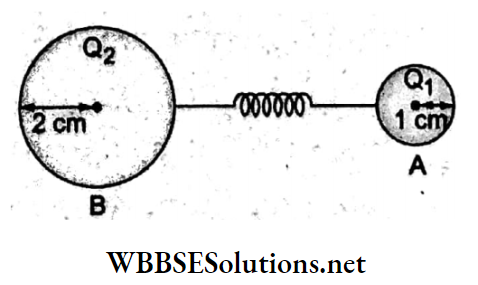
Question 58. There is an electric field \(\vec{E}\) along the x-direction. If the work done on moving a charge of 0.2 C through a distance of 2 m along a line making an angle 60° with the x-axis is 4 J then the value of E is
- 5 NC-1
- 20 NC-1
- √3 NC-1
- 4 NC-1
Answer: 2. 20 NC-1
Work done = \(W=\vec{F} \cdot \vec{S}=q \vec{E} \cdot \vec{S}=q E S \cos \theta\)
Here, q = 0.2 C, S = 2 m, 0 = 60° and W = 4J.
Substituting the values, 4 J = (0.2 C) E(2 m) cos 60° = E(0.2 C m).
∴ \(E=\frac{4 \mathrm{~J}}{0.2 \mathrm{Cm}}\)
= 20 V m-1 or 20 NC-1
Question 59. An electric dipole of dipole moment p is placed in the position of stable equilibrium in a uniform electric field E. It is rotated through an angle 0 from the initial position. The potential energy of the electric dipole in the final position is
- -pE cos θ
- pE (1- cos θ)
- pE cos θ
- pE sin θ
Answer: 1. -pE cos θ
The PE of an electric dipole of the moment \(\vec{p}\) in a uniform electric field \(\vec{E}\) is given by \(U=-\vec{p} \cdot \vec{E}=-p E \cos \theta\)
The dipole is the most stable when the PE is minimal and this occurs
at θ = 0°.
When rotated through an angle θ, work done = Uf– Ui
=> pE(1- cos θ) = Uf– (-pE)
=> Uf = -pE cosθ.
Question 60. A network of four capacitors of capacitances C1 = C, C2 = 2C, C3 = 3C, and C4 = 4C is connected to a battery as shown in the adjoining figure. The ratio of the charges on C2 and C4 is
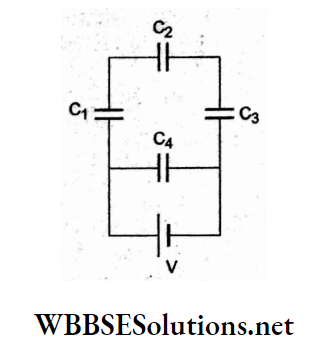
- \(\frac{4}{7}\)
- \(\frac{3}{22}\)
- \(\frac{7}{4}\)
- \(\frac{22}{3}\)
Answer: 2. \(\frac{3}{22}\)
The given network can be redrawn as shown.
The equivalent capacitance of the series combination is \(\frac{6}{11}\)C.
Charge Q is the same on each capacitor in series, where Q = Q1 = Q2 = Q3 = Ceq.V = \(\frac{6}{11}\)CV.
The charge on C4 is Q4 = (4C) V
⇒ \(\frac{Q_2}{Q_4}=\frac{\frac{6}{11} C V}{4 C V}\)
= \(\frac{3}{22}\)
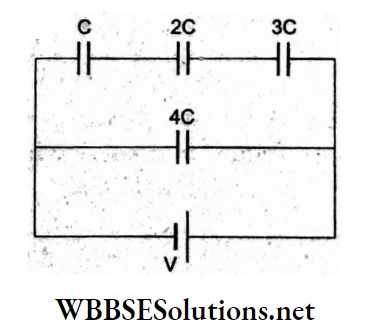
Question 61. Three capacitors, each of capacitance 4μF, are to be connected in such a way that the effective capacitance is 6 μF. This can be done by
- Connecting All Of them in a series
- Connecting Them in parallel
- Connecting Two In series and one in parallel
- Connecting Two In parallel and one in series
Answer: 3. Connecting two in series and one in parallel
Two capacitors in series give a capacitance of 2 μF. When this combination is connected in parallel to the 3rd capacitor, we get
Ceq = 2 μF + 4 μF
= 6 μF.
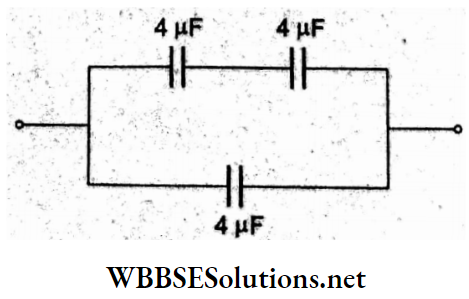
Question 62. A capacitor of capacitance C1 is charged up to V volts and then connected to an uncharged capacitor of capacitance C2. The final potential difference across each will be
- \(\frac{C_2 V}{C_1+C_2}\)
- \(\frac{C_1 V}{C_1+C_2}\)
- \(\left(1+\frac{C_2}{C_1}\right) V\)
- \(\left(1-\frac{C_2}{C_1}\right) V\)
Answer: 2. \(\left(1+\frac{C_2}{C_1}\right) V\)
When the capacitor C1 is charged to a potential of V volts, its charge is Q = C1V. When connected in parallel to the uncharged C2, the common potential is
⇒ \(V=\frac{Q_1}{C_1}=\frac{Q_2}{C_2}\)
= \(\frac{Q_1+Q_2}{C_1+C_2}\)
= \(\frac{\text { total charge }}{C_1+C_2}\)
= \(\frac{Q}{C_1+C_2}\)
= \(\frac{C_1 V}{C_1+C_2}\)
Question 63. What is the effective capacitance across the terminals x and y?
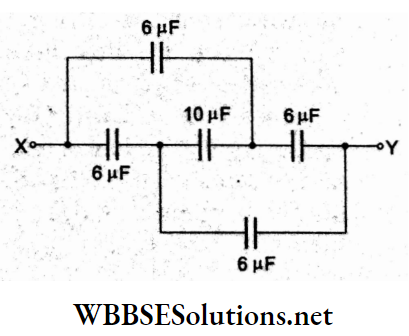
- 12 μF
- 18 μF
- 24μF
- 6 μF
Answer: 4. 6 μF
The given network of capacitors can be redrawn as shown in the figure. The applied voltage across X and Y is equally divided across the two capacitors of equal capacitance in the upper and lower branches, so points A and B will be at the same potential. The 10-μF capacitor will be ineffective.
Hence, the equivalent I capacitance across X and Y will be
⇒ \(C_{e q}=3 \mu \mathrm{F}+3 \mu \mathrm{F}=6 \mu \mathrm{F}\)
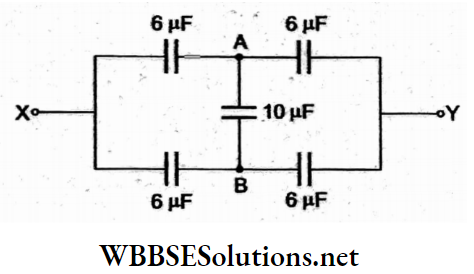
Question 64. Two parallel metal plates having charges +Q and -Q face each other at a certain distance. If the plates are now dipped in kerosene oil and kept in a tank, the electric field between the plates will
- Become zero
- Increase
- Decrease
- Remain the same
Answer: 3. Decrease
The electric field between the plates of a charged capacitor with air between the plates is
⇒ \(E=\frac{\sigma}{\varepsilon_0}\), where a = surface charge density.
When immersed in a liquid (here kerosene oil), the field is charged to \(E^{\prime}=\frac{\sigma}{K \varepsilon_0}\) where K = relative permittivity (or dielectric constant) of kerosene oil.
Since K >1, E’ < E.
Question 65. Three capacitors, each of capacitance C and of breakdown voltage V, are joined in series. The capacitance and breakdown voltage for the given combination will be
- 3C, \(\frac{V}{3}\)
- \(\frac{C}{3}\),3V
- 3C,3V
- \(\frac{C}{3}\), \(\frac{V}{3}\)
Answer: 2. \(\frac{C}{3}\),3V
The equivalent capacitance in series grouping is
⇒ \(\frac{1}{C_{\mathrm{eq}}}=\frac{1}{C}+\frac{1}{C}+\frac{1}{C}\)
= \(\frac{3}{C}\)
⇒ \(C_{\text {eq }}=\frac{C}{3}\)
Since the voltage across each equal capacitor in series is the same (equal to breakdown voltage V), the breakdown voltage across the combination is 3V.
Question 66. Two capacitors, one of capacitance C and the other of capacitance C/2, are connected to a V-volt battery as shown in the figure. The work in fully charging both the capacitors is
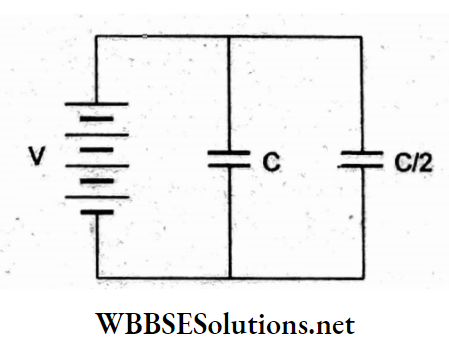
- \(\frac{1}{4}\)CV²
- \(\frac{3}{4}\)CV²
- \(\frac{1}{2}\)CV²
- 2CV²
Answer: 2. \(\frac{3}{4}\)CV²
Work done in charging toe capacitor = electrostatic energy stored in the capacitor, hence
⇒ \(W=\frac{1}{2} C V^2\).
The equivalent capacitance (in the parallel combination) is \(C+\frac{C}{2}=\frac{3}{2} C\) C and the voltage across it is V.
Hence, the total work done is
⇒ \(W=\frac{1}{2}\left(\frac{3}{2} C\right) V^2=\frac{3}{4} C V^2\)
Question 67. A parallel-plate air capacitor is charged to a potential difference of V volts. After disconnecting the charging battery, the separation between the plates of the capacitor is increased using an insulating handle. As a result, the potential difference between the plates
- Increases
- Decreases
- Does not change
- Becomes zero
Answer: 1. Increases
After the charging battery is disconnected, the charge on the plates of the capacitor will remain unchanged. When the separation between the plates (4) is increased, the capacitance \(\left(C=\frac{\varepsilon_0 A}{d}\right)\) will decrease.
Consequently, the potential difference between the plates \(\left(V=\frac{Q}{C}\right)\) will increase.
Question 68. Two thin dielectric slabs of dielectric constants K1 and K2 (K1 < K2) are inserted between the plates of a parallel-plate capacitor, as shown in the figure. The variation of the electric field between the plates with a distance d as measured from the plate P is correctly shown in
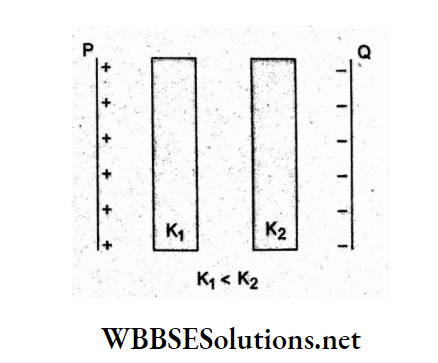
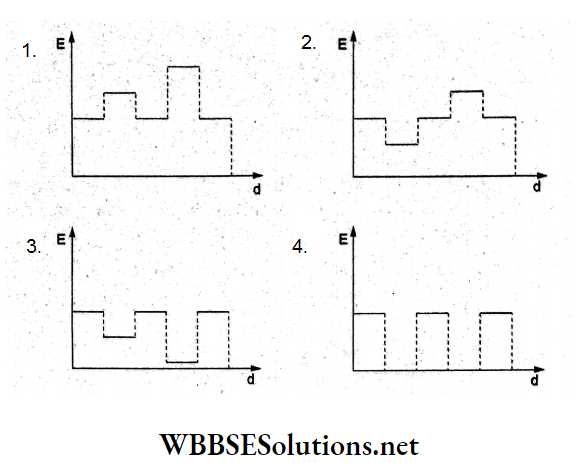
Answer: 3.
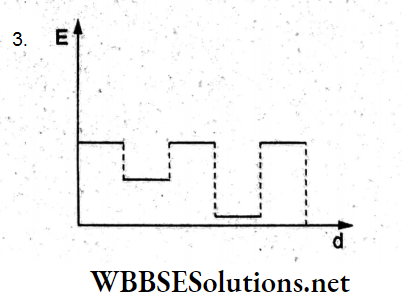
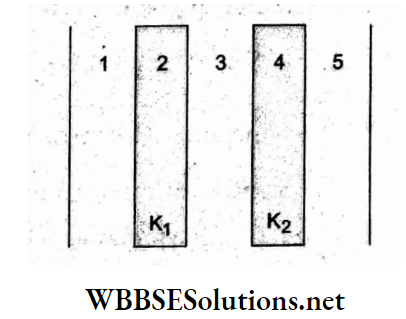
Let us divide the space between the plates of the charged capacitor into five regions.
In regions 1, 3, and 5 the medium is air, so the field
⇒ \(E_1=E_3=E_5=\frac{\sigma}{2 \varepsilon_0}\)
In the region 2, field \(E_2=\frac{\sigma}{2 K_1 \varepsilon_0}\) and in die region 4, field \(E_4=\frac{\sigma}{2 K_2 \varepsilon_0}\)
Since K1 < K2, E2 > E4.
Thus, E1 = E3 = E5 > E2 > E4 as shown in option (3).
Question 69. A series combination of n1 capacitors, each of value C1 is charged by a source of potential difference 4V. When another parallel combination of n2 capacitors, each of value C2, is charged by a voltage source of V, it has the same (total) energy stored in it as the series combination has. The value of C2, in terms of C1, is then
- \(\frac{2 C_1}{n_1 n_2}\)
- \(\frac{16 n_2 C_1}{n_1}\)
- \(\frac{2 n_2 C_1}{n_1}\)
- \(\frac{16 C_1}{n_1 n_2}\)
Answer: 4. \(\frac{16 C_1}{n_1 n_2}\)
Equivalent capacitance in series grouping = \(\frac{C_1}{n_1}\) . When connected across a voltage source of 4V, the energy stored is
⇒ \(u_1=\frac{1}{2}\left(\frac{C_1}{n_1}\right)(4 V)^2\)
Equivalent capacitance in parallel grouping = n2C2. When connected across the source of voltage V, the energy stored is \(U_2=\frac{1}{2}\left(n_2 C_2\right) V^2\)
Given,
⇒ \(U_1=U_2\)
⇒ \(\frac{1}{2}\left(\frac{C_1}{n_1}\right) 16 V^2\)
⇒ \(\frac{1}{2} n_2 C_2 V^2\)
⇒ \(C_2=\frac{16 C_1}{n_1 n_2}\)
Question 70. A parallel-plate air capacitor has capacitance C and the separation between the plates is d. A potential difference V is applied between the plates. The force of attraction between the plates will be
- \(\frac{C V^2}{d}\)
- \(\frac{C^2 V^2}{2 d^2}\)
- \(\frac{C^2 V^2}{2 d}\)
- \(\frac{C V^2}{2 d}\)
Answer: 4. \(\frac{C V^2}{2 d}\)
The electric field between the plates of a charged capacitor is
⇒ \(E=\frac{\sigma}{\varepsilon_0}=\frac{V}{d} \Rightarrow \sigma=\frac{\varepsilon_0 V}{d}\)….(1)
The field due to a single plate is \(\frac{\sigma}{2 \varepsilon_0}\)
The negative plate will experience an attractive force in this field \(\left(\frac{\sigma}{2 \varepsilon_0}\right)\).
This force is given by
⇒ \(F=Q\left(\frac{\sigma}{2 \varepsilon_0}\right)=(\sigma A)\left(\frac{\sigma}{2 \varepsilon_0}\right)=\sigma^2 \frac{A}{2 \varepsilon_0}\)
Substituting σ from the equation (1),
⇒ \(F=\left(\frac{\varepsilon_0 V}{d}\right)^2 \cdot \frac{A}{2 \varepsilon_0}\)
= \(\left(\frac{\varepsilon_0 A}{d}\right) \frac{V^2}{2 d}\)
= \(\frac{C V^2}{2 d}\)
Question 71. A parallel-plate air capacitor of capacitance C is connected to a cell of emf Vand and then disconnected from it. A dielectric slab of dielectric constant K, which can just fill the air gap between the plates is now inserted in it. Which of the following statements is incorrect?
- The change in potential energy stored is \(\frac{1}{2} C V^2\left(\frac{1}{K}-1\right)\)
- The charge on the capacitor is not conserved.
- The potential difference between the plates decreases K times.
- The energy stored in the capacitor decreases K times.
Answer: 2. The charge on the capacitor is not conserved.
When the plates of the capacitor are not touched, the charge always remains conserved. So, the option (2) is incorrect.
Change in potential energy = \(u_f-u_i=\frac{Q^2}{2 C^{\prime}}-\frac{Q^2}{2 C}\)
⇒ \(\frac{Q^2}{2 K C}-\frac{Q^2}{2 C}=\frac{1}{2} C V^2\left(\frac{1}{K}-1\right)\)
So, the option (1) is correct.
Potential difference are \(V=\frac{Q}{C} \text { and } V^{\prime}=\frac{Q}{C^{\prime}}=\frac{Q}{K C}\)
So, V’ < V. Therefore, option (3) is correct.
From option (4), (Uf– Ui) is negative, so the energy stored in the capacitor decreases, which is correct. Hence, all the options are correct except (2).
Question 72. A parallel-plate capacitor has a uniform electric field E in the space between the plates. If the separation between the plates is d and the area of each plate is A, the energy stored in the capacitor is
- \(\frac{1}{2} \varepsilon_0 E^2\)
- \(\frac{E^2 A d}{\varepsilon_0}\)
- \(\frac{1}{2} \varepsilon_0 E^2 A d\)
- E0EAd
Answer: 3. \(\frac{1}{2} \varepsilon_0 E^2 A d\)
The energy stored in the capacitor is \(U=\frac{1}{2} C V^2, \text { where } C=\frac{\varepsilon_0 A}{d}\), and the
electric field is \(E=\frac{V}{d} \Rightarrow V=E d\)
Substituting these values, energy stored, U is
⇒ \(\frac{1}{2}\left(\frac{\dot{\varepsilon}_0 A}{d}\right)(E d)^2=\frac{1}{2} \varepsilon_0 E^2 A d\)
Question 73. A capacitor is charged by a battery. The battery is removed and another identical uncharged capacitor is connected in parallel. The total electrostatic energy of the resulting system
- Decreases by a factor of 2
- Remains unchanged
- Increases by a factor of 2
- Increases by a factor of 4
Answer: 1. Decreases by a factor of 2
The energy of a charged capacitor is \(U_i=\frac{Q^2}{2 C}\). When another identical capacitor is connected in parallel with the battery removed, the charge Q remains unchanged but C increases to 2C. Hence, the final energy
\(U_f=\frac{1}{2} \cdot \frac{Q^2}{2 C}\)∴ the decrease in energy is \(U_i-U_f=\frac{Q^2}{2 C}-\frac{Q^2}{4 C}=\frac{1}{2}\left(\frac{Q^2}{2 C}\right)\).
The energy decreases by a factor of 2.
Question 74. A capacitor of 2μF is charged as shown in the diagram. When the switch S is turned to the position 2, the percentage of stored energy dissipated is
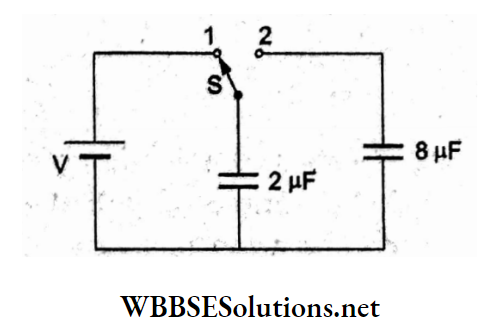
- 75
- 80
- 10
- 20
Answer: 2. 80
The energy stored in the 2-μF capacitor is \(U_1=\frac{Q^2}{2 C_1}\) When the switch is turned to position 2, the battery is disconnected and the capacitors are joined in parallel with charge Q remaining the same and the capacitors are joined in parallel with charge Q remaining the same.
Thus, final energy = \(U_2=\frac{Q^2}{2\left(C_1+C_2\right)}\)
Hence, fractional loss of energy = \(\frac{u_1-u_2}{u_1}=\left(1-\frac{u_2}{u_1}\right)\)
⇒ \(=\left(1-\frac{C_1}{C_1+C_2}\right)\)
= \(\left(1-\frac{2}{10}\right)\)
= \(\frac{8}{10}\)
∴ per cent loss = \(\frac{8}{10}\) x 100%
= 80%.
Question 75. A parallel-plate capacitor of area A, plate separation d, and capacitance C is filled with four dielectric materials having dielectric constants K1, K2, K3, and K44 as shown in the figure. If a single dielectric material is to be used to have the same capacitance C in the capacitor then its dielectric constant K will be given by
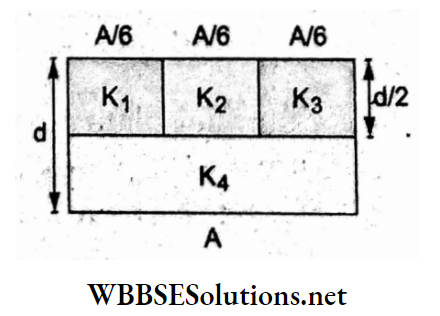
- k = k1 + k2 + k3 + 3k4
- \(\mathrm{k}=\frac{2}{3}\left(k_1+k_2+k_3\right)+2 k_4\)
- \(\frac{2}{k}=\frac{3}{k_1+k_2+k_3}+\frac{1}{k_4}\)
- \(\frac{1}{k}=\frac{1}{k_1}+\frac{1}{k_2}+\frac{1}{k_3}+\frac{3}{2 k_4}\)
Answer: 3. \(\frac{2}{k}=\frac{3}{k_1+k_2+k_3}+\frac{1}{k_4}\)
The given system can be considered as a combination of four capacitors, as shown in the adjoining figure
The capacitances are:
⇒ \(C_1=\frac{K_1 \varepsilon_0 A / 3}{d / 2}=\frac{2}{3} \frac{K_1 \varepsilon_0 A}{d}\)
⇒ \(C_2=\frac{2}{3} \frac{K_2 \varepsilon_0 A}{d}, C_3=\frac{2}{3} \frac{K_3 \varepsilon_0 A}{d}\)
⇒ \(C_4=\frac{2 K_4 \varepsilon_0 A}{d}\)
If C is the equivalent capacitance then
⇒ \(\frac{1}{C}=\frac{1}{C_1+C_2+C_3}+\frac{1}{C_4}\)
⇒ \(\frac{d}{K \varepsilon_0 A}=\frac{3 d}{2 \varepsilon_0 A\left(K_1+K_2+K_3\right)}+\frac{d}{2 K_4 \varepsilon_0 A}\)
⇒ \(\frac{2}{K}=\frac{3}{K_1+K_2+K_3}+\frac{1}{K_4}\)
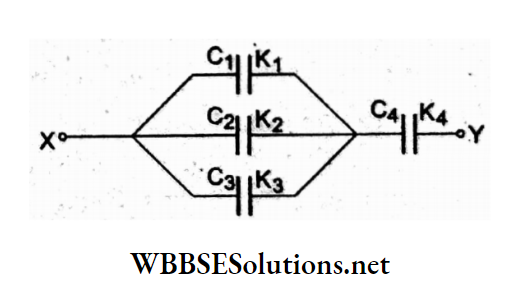
Question 76. The voltage of some clouds is 4 x 106, volts with respect to the ground. In a lightning strike lasting for 100 milliseconds, a charge of 4 coulombs is delivered to the ground. The power of the lightning strike is
- 160 MW
- 80 MW
- 20 MW
- 500 MW
Answer: 2. 80 MW
Given that potential difference V = 4 x 106 V, time = 100 ms = 100 x 10-3 s, charge = Q = 4C.
Work done = W = \(\frac{1}{2}\) QV.
Hence power of the lightning strike is
⇒ \(P=\frac{W}{t}=\frac{1}{2} \frac{Q V}{t}=\frac{1}{2} \frac{\left(4 \times 4 \times 10^6\right) J}{0.18}\)
= 8 x 107 W
= 80 MW.
Question 77. Five capacitors, each of capacitance C, are connected as shown in the figure. The ratio of the capacitance between P and R and that between P and R is
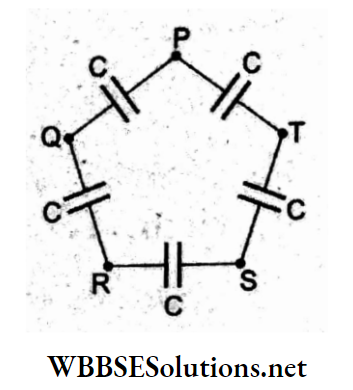
- 3:1
- 5:2
- 2:3
- 1:1
Answer: 3. 2:3
The two adjoining figures show the connection between P and R and that across P and Q.
In the first case, \(C_{\mathrm{PR}}=\frac{C}{3}+\frac{C}{2}=\frac{5}{6} C\)
In the second case, \(C_{\mathrm{PQ}}=\frac{C}{4}+C=\frac{5}{4} C\)
∴ required ratio = \(\frac{C_{P R}}{C_{P Q}}=\frac{5 C / 6}{5 C / 4}\)
= \(\frac{2}{3}\)
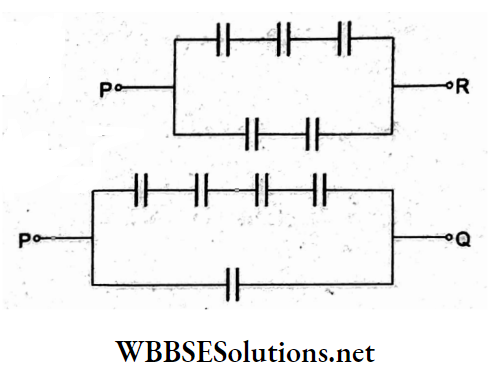
Question 78. What is the energy stored in the capacitor between terminals a and b of the network shown in the figure? (Given the capacitance of each capacitor, C = 1μF.)
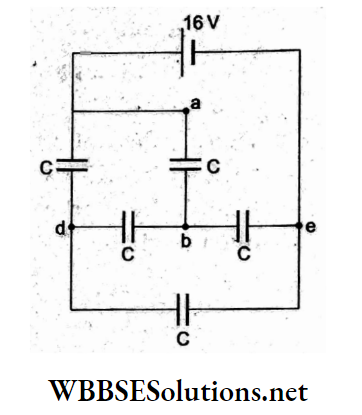
- 12.5 μJ
- Zero
- 25 μJ
- 50μJ
Answer: 1. 12.5 μJ
The circuit consisting of five identical capacitors, each of capacitance 1 pF, is redrawn as shown in the figure.
The potential difference across each capacitor is equally divided and the combination constitutes a balanced Wheatstone bridge.
The energy stored in the capacitor across ab is
⇒ \(U=\frac{1}{2} C V^2=\frac{1}{2}\left(10^{-6} \mathrm{~F}\right)(5 \mathrm{~V})^2=12.5 \mu \mathrm{J}\)
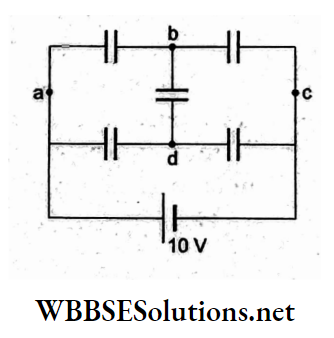
Question 79. What would be the voltage across C3?
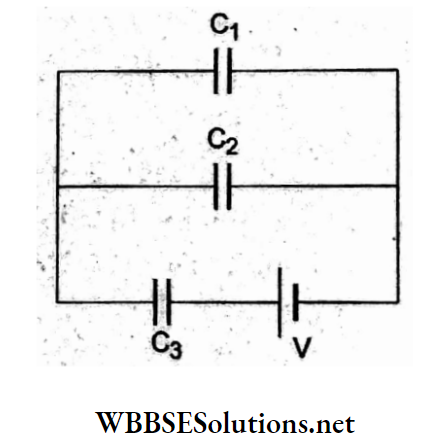
- \(\frac{\left(C_1+C_2\right) V}{C_1+C_2+C_3}\)
- \(\frac{C_1 V}{C_1+C_2+C_3}\)
- \(\frac{C_2 V}{C_1+C_2+C_3}\)
- \(\frac{C_3 V}{C_1+C_2+C_3}\)
Answer: 1. \(\frac{\left(C_1+C_2\right) V}{C_1+C_2+C_3}\)
The given combination of capacitors consists of C1 and C2 in parallel, which is connected in series with C3 as shown in the adjoining figure. The equivalent combination of C1 and C2 is (C1 + C2). This, in series with C3, gives,
⇒ \(\frac{1}{C_{\mathrm{eq}}}=\frac{1}{C_1+C_2}+\frac{1}{C_3}\)
= \(\frac{C_1+C_2+C_3}{\left(C_1+C_2\right) C_3}\)
⇒ \(C_{\text {eq }}=\frac{\left(C_1+C_2\right) C_3}{C_1+C_2+C_3}\)
Charge delivered to the combination = Q = Ceq.V
⇒ \(\frac{\left(C_1+C_2\right) C_3 V}{C_1+C_2+C_3}\)
∴ the voltage across C3, is
⇒ \(\frac{Q}{C_3}=\frac{\left(C_1+C_2\right) V}{C_1+C_2+C_3}\)
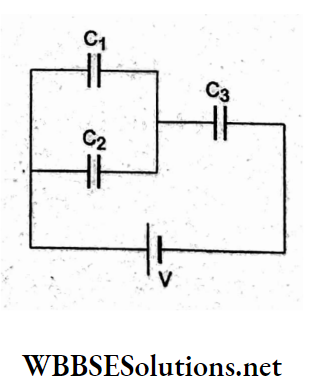
Question 80. The diameter of the plate of a parallel-plate capacitor is 6 cm. If its capacitance is equal to that of a sphere with a diameter of 200 cm, the Separation between the plates of the capacitor is
- 4.5 x 10-4 m
- 2.25 x 10-4 m
- 6.75 x 10-4 m
- 9 x 10-4 m
Answer: 2. 2.25 x 10-4 m
The capacitance of a parallel-plate capacitor is
⇒ \(C_1=\frac{\varepsilon_0 A}{d}\)
= \(\frac{\varepsilon_0\left(\pi D^2 / 4\right)}{d}\)
This is equal to the capacitance of a sphere of radius R = \(\frac{200}{2}\) cm =1.0 m, which is C2 = 4πε0R.
∵ \(C_1=C_2 \text { (given), } \frac{\varepsilon_0 \pi D^2}{4 d}\)
= \(4 \pi \varepsilon_0 R\)
∴ the separation between the plates is,
⇒ \(d=\frac{D^2}{16 R}\)
= \(\frac{\left(6 \times 10^{-2} \mathrm{~m}\right)^2}{16(1.0 \mathrm{~m})}\)
= \(\frac{36}{16} \times 10^{-4} \mathrm{~m}\)
= 2.25 x 10-4 m.
Question 81. A parallel-plate capacitor with air as a dielectric has capacitance C. A slab of dielectric constant K having the same thickness as the separation between the plates is introduced so as to fill one-fourth of the capacitor as shown in the figure. The new capacitance will be
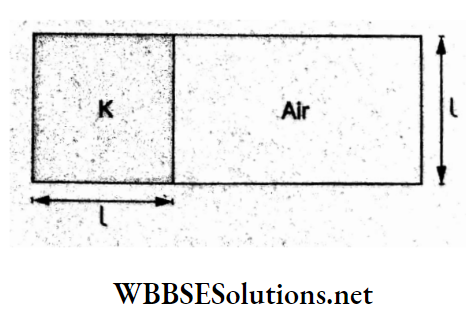
- (K + 3) [lartex]\frac{C}{4}[/latex]
- (K + 2) [lartex]\frac{C}{4}[/latex]
- (K + 1) [lartex]\frac{C}{4}[/latex]
- [lartex]\frac{KC}{4}[/latex]
Answer: 1. (K + 3) [lartex]\frac{C}{4}[/latex]
For the air capacitor, the capacitance is C = where A is the total area of each plate.
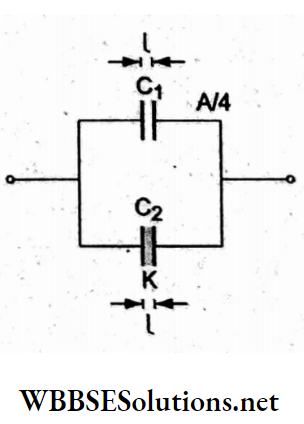
After the dielectric is introduced between the plates, we have a situation equivalent to a parallel combination of two capacitors, as shown in the figure.
In this, \(C_1=\frac{\varepsilon_0 3 A / 4}{l}\)
and, \(C_2=\frac{K \varepsilon_0 A / 4}{l}\)
∴ equivalent capacitance \(C_{\mathrm{eq}}=C_1+C_2=\frac{3}{4} \frac{\varepsilon_0 A}{l}+\frac{K}{4} \frac{\varepsilon_0 A}{l}\)
⇒ \((3+K) \frac{\varepsilon_0 A}{4 l}\)
= \((k+3) \frac{C}{4}\)
Question 82. A hollow metal sphere of radius R is uniformly charged. The electric field due to the sphere at a distance r from the center
- Increases as r increases for r < R and for r > Rasa
- Is zero as r increases for r < R, decreases as r increases for r > R
- Is zero as r increases for r < R, increases as r increases for r > R
- Decreases as r increases for r < R and for r > R
Answer: 2. Is zero as r increases for r < R, decreases as r increases for r > R
A charged conducting spherical shell has zero electric fields in the cavity, so E = 0 for 0 < r < R. At an external point, the field E is the same as if the total charge were centered at the center of the sphere, obeying the inverse square law \(\left(E \propto \frac{1}{r^2}\right)\) Thus, E decreases as r increased for r>R.
Question 83. Two parallel, infinite line charges with uniform line charge densities +λ. C m-1 and -λ C m-1 are placed at a distance of 2R from each other in free space. What is the electric field midway between the two line charges?
- \(\frac{2 \lambda}{\pi \varepsilon_0 R} \mathrm{NC}^{-1}\)
- \(\frac{\lambda}{2 \pi \varepsilon_0} \mathrm{NC}^{-1}\)
- \(\frac{\lambda}{\pi \varepsilon_0 R} \mathrm{NC}^{-1}\)
- Zero
Answer: 3. \(\frac{\lambda}{\pi \varepsilon_0 R} \mathrm{NC}^{-1}\)
According to Gauss’s theorem, the electric
field due to a line charge is
⇒ \(\vec{E}=\frac{\lambda}{2 \pi \varepsilon_0 r} \hat{i}\)
where r is the distance from the line charge. Here, at the midpoint 0,r = R, and the fields due to the two line charges are along the same direction (along the x-axis). These fields add up to give the net field
⇒ \(\vec{E}=\frac{\lambda}{2 \pi \varepsilon_0 R} \hat{i}+\frac{\lambda}{2 \pi \varepsilon_0 R} \hat{i}=\frac{\lambda}{\pi \varepsilon_0 R} \hat{i} \mathrm{~N} \mathrm{C}^{-1}\)
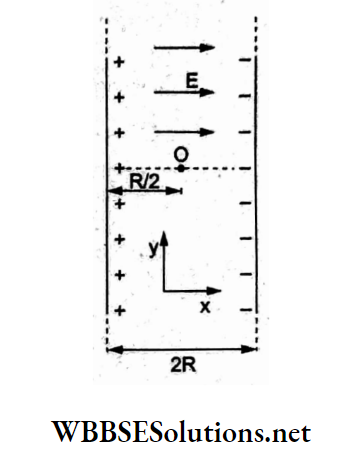
Question 84. Two points A and B having charges +Q and -Q respectively are placed a certain distance apart. The force between them is F. If 25% charge of A is transferred to B then the force between the charges becomes
- F
- \(\frac{9F}{16}\)
- \(\frac{16F}{9}\)
- \(\frac{4F}{3}\)
Answer: 2. \(\frac{9F}{16}\)
Initially, the charges are + Q and -Q, so F = \(F=K \frac{Q^2}{r^2}\) (attraction).
Finally, when \(\frac{Q}{4}\) is transferred from A to B, the charge on A is \(Q_1=Q-\frac{Q}{4}=\frac{3}{4} Q\) and the charge on B is \(Q_2=(-Q)+\left(\frac{Q}{4}\right)=-\frac{3}{4} Q\)
∴ the force F’ = \(\frac{K Q_1 Q_2}{r^2}=\frac{K\left(\frac{3}{4} Q\right)\left(\frac{3}{4} Q\right)}{r^2}\) (attraction)
⇒ \(\frac{9}{16}\left(K \frac{Q^2}{r^2}\right)\)
= \(\frac{9}{16} F\)
Question 85. Find the charge on the capacitor 1 s after the switch is opened at t = ∞.
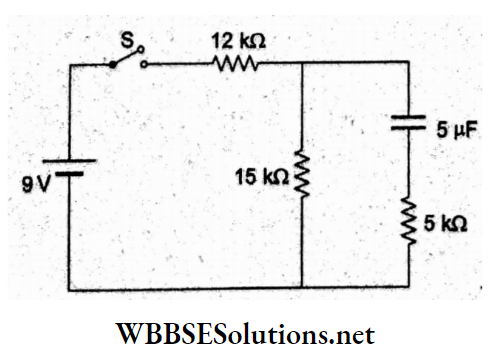
- 20 e-10 μC
- 30 e-10 μC
- 35 e-10 μC
- 25 e-10 μC
Answer: 4. 25 e-10 μC
In the state, the current through the 15-kΩ resistance,
⇒ \(I=\frac{9 \mathrm{~V}}{27 \mathrm{k} \Omega}=\frac{1}{3} \times 10^{-3} \mathrm{~A} .\)
The PD across the capacitor is
V = \((15 \mathrm{k} \Omega)\left(\frac{10^{-3}}{3} \mathrm{~A}\right)\)
= 5 V.
Charge Q0 = CV
=(5x 106 F) (5 V)
= 25 pC.
= time constant CR = (5 μF) (20 kΩ) = 0.1 s
= \(Q=Q_0 e^{-t / C R}\)
= \((25 \mu \mathrm{C}) e^{-1 \mathrm{~s} / 0.1 \mathrm{~s}}\)
= \(\frac{25 \mu \mathrm{C}}{e^{10}}\)
= \(25 \times e^{-10} \mu \mathrm{C}\)
Question 86. A capacitor of capacitance 15 nF having a dielectric slab of 2.5 and dielectric strength of 30 MV m-1 has a potential difference of 30 V across its plates. The minimum area of its plates is
- 8.4 x 10-4 m2
- 6.7 x 10-4 m2
- 9.8 x 10-4 m2
- 42 x 10-4 m2
Answer: 2. 6.7 x 10-4 m2
The electric field between the plates of the capacitor,
⇒ \(E=\frac{\sigma}{K \varepsilon_0}=\frac{Q}{K \varepsilon_0 A}\)
Plate area = \(A=\frac{Q}{K \varepsilon_0 A}\)
But \(Q=C V \Rightarrow A=\frac{C V}{K \varepsilon_0 E}\)
Substituting the given values,
⇒ \(A=\frac{\left(15 \times 10^{-9} \mathrm{~F}\right)(30 \mathrm{~V})}{(2.5)\left(8.85 \times 10^{-12} \mathrm{Fm}^{-1}\right)\left(30 \times 10^6 \mathrm{Vm}^{-1}\right)}\)
= 6.7 x 10-4 m2.
Question 87. In the steady state, the charge on the capacitor is
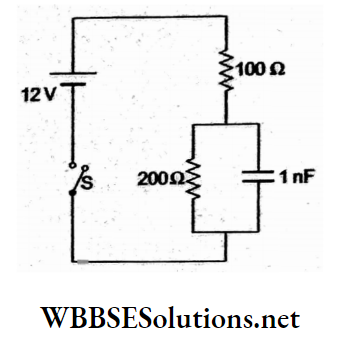
- 8 nC
- 10 nC
- 12 nC
- 5 nC
Answer: 1. 8nC
In the steady state, current through the 200-Ω resistor \(I=\frac{12 \mathrm{~V}}{300 \Omega}=\frac{4}{100} \mathrm{~A}\) Charge \(Q=C V\)
= \(\left(1 \times 10^{-9} \mathrm{~F}\right)\left(\frac{4}{100} \times 200 \mathrm{~V}\right)\)
= 8nC.
Question 88. Four equal point charges Q are placed in the xy-plane at (0, 2), (4, 2), (4, -2) and (0, -2). The work required to put a fifth charge Q at the origin of the coordinate system will be
- \(\frac{Q^2}{4 \pi \varepsilon_0}\)
- \(\frac{Q^2}{4 \pi \varepsilon_0}\left(1-\frac{1}{\sqrt{3}}\right)\)
- \(\frac{Q^2}{2 \sqrt{2} \pi \varepsilon_0}\)
- \(\frac{Q^2}{4 \pi \varepsilon_0}\left(1+\frac{1}{\sqrt{5}}\right)\)
Answer: 4. \(\frac{Q^2}{4 \pi \varepsilon_0}\left(1+\frac{1}{\sqrt{5}}\right)\)
The positions of four equal charges are given in the figure.
The net potential at the origin O is
⇒ \(V=K Q\left(\frac{1}{2}+\frac{1}{2}+\frac{2}{\sqrt{20}}\right)\)
= \(\frac{2 K Q}{2}\left(1+\frac{1}{\sqrt{5}}\right)\)
Work done W=QV
= \(K Q^2\left(1+\frac{1}{\sqrt{5}}\right)\)
⇒ \(\frac{Q^2}{4 \pi \varepsilon_0}\left(1+\frac{1}{\sqrt{5}}\right)\)
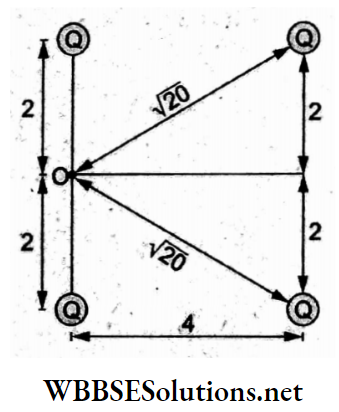
Question 89. A charge Q is distributed over three concentric spherical shells of radii a, b, and c (a < b < c) such that their surface densities of charge are equal. The total potential at a point at a distance r (r < a) from their common center would be
- \(\frac{Q\left(a^2+b^2+c^2\right)}{4 \pi \varepsilon_0\left(a^3+b^3+c^3\right)}\)
- \(\frac{Q(a+b+c)}{4 \pi \varepsilon_0\left(a^2+b^2+c^2\right)}\)
- \(\frac{Q}{4 \pi \varepsilon_0(a+b+c)}\)
- \(\frac{Q}{12 \pi \varepsilon_0} \frac{a b+b c+c a}{a b c}\)
Answer: 2. \(\frac{Q(a+b+c)}{4 \pi \varepsilon_0\left(a^2+b^2+c^2\right)}\)
Let the charges on the three spherical shells be q1,q2 and q3. For equal surface densities,
⇒ \(\sigma=\frac{q_1}{4 \pi a^2}=\frac{q_2}{4 \pi b^2}=\frac{q_3}{4 \pi c^2}\)
⇒ \(\frac{q_1}{a^2}=\frac{q_2}{b^2}=\frac{q_3}{c^2}=\alpha\)
= \(\frac{q_1+q_2+q_3}{a^2+b^2+c^2}\)
⇒ \(\frac{Q}{a^2+b^2+c^2}\)
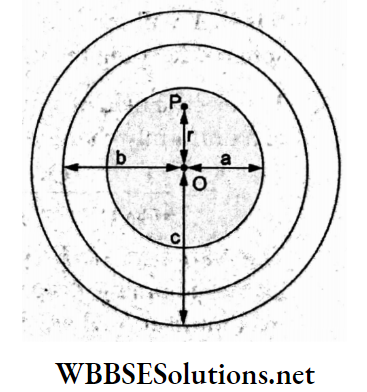
Question 90. The bob of a simple pendulum has a mass of 2 g and a charge of 5.0 μC. It rests in a uniform horizontal electric field of intensity 2000 V m-1. At equilibrium, the angle that the pendulum makes with the vertical is
- tan-1 (5.0)
- tan-1 (2.0)
- tan-1 (0.5)
- tan-1 (0.2)
Answer: 3. tan-1 (0.5)
Resolving the tension T along the horizontal and vertical directions,
Tsin θ = qE and Tcos θ = mg.
Dividing, we get,
⇒ \(\tan \theta=\frac{q E}{m g}=\frac{\left(5 \times 10^{-6} \mathrm{C}\right)\left(2 \times 10^3 \mathrm{~V} \mathrm{~m}^{-1}\right)}{\left(2 \times 10^{-3} \mathrm{~kg}\right)\left(10 \mathrm{~m} \mathrm{~s}^{-2}\right)}\) = 0.5
=> 0 = tan-1(0.5).
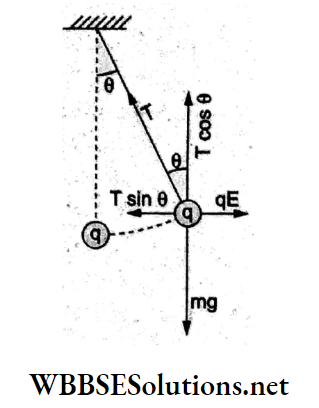
Question 91. Three charges + Q,q, and + Q are placed at distances 0, \(\frac{d}{2}\) and d from the origin on the x-axis. If the net force experienced by +Q placed at x = 0 is zero, the value of q is
- +\(\frac{Q}{2}\)
- +\(\frac{Q}{4}\)
- –\(\frac{Q}{2}\)
- –\(\frac{Q}{4}\)
Answer: 4. –\(\frac{Q}{4}\)
The net force on charge +Q at the origin O will be zero if the force due to q at x = \(\frac{d}{2}\)is equal and opposite to that due to +Q at x = d.
Hence, q must have a negative value.
∴ \(F_{\text {net }}=-\frac{K Q q}{\left(\frac{d}{2}\right)^2}\)
= \(-\frac{K Q^2}{d^2}\)
Hence, q = –\(\frac{Q}{4}\)
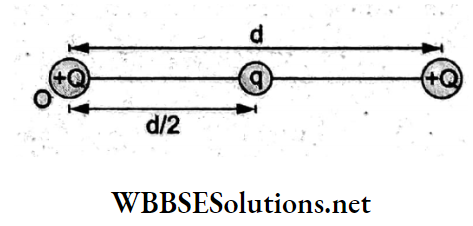
Question 92. A solid conducting sphere having a charge Q is surrounded by a hollow spherical shell that is uncharged and conducting. Let the potential difference between the surface of the solid sphere and that of the outer surface of the hollow shell be V. If the shell is now given a charge of -4Q, the new potential difference between the same two surfaces is
- V
- 2 V
- -2 V
- 4 V
Answer: 1. V
The potential at any point in a spherical shell’s cavity is constant and the same as that on its surface. Hence, adding a charge (= -4Q) to this shell will cause an equal change of potential in the outer and inner spheres, keeping the initial potential difference V unchanged.
Question 93. For a uniformly charged ring of radius R, the electric field on its axis has the maximum value at a distance x from its center. The value of x is
- \(\frac{R}{\sqrt{2}}\)
- R√2
- R
- \(\frac{R}{\sqrt{5}}\)
Answer: 1. \(\frac{R}{\sqrt{2}}\)
The electric field at a point P on the axis of a uniformly charged ring is given by +
⇒ \(E=\frac{1}{4 \pi \varepsilon_0} \frac{Q x}{\left(R^2+x^2\right)^{3 / 2}}\)
The variation of E with x is shown in the adjoining graph.
The field E is maximum at A where the slope
⇒ \(\frac{d E}{d x}=0\)
Thus,
⇒ \(\frac{1}{\left(R^{2+}+x^2\right)^{3 / 2}}-\frac{3}{2} \frac{x \cdot 2 x}{\left(R^2+x^2\right)^{5 / 2}}=0\)
3x² = R²+x².
⇒ \(x= \pm \frac{R}{\sqrt{2}}\)
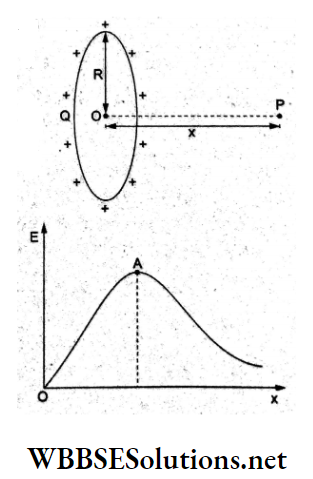
Question 94. In free space, a particle A of charge1 pC is held fixed at a point P. Another particle B of the same charge and mass 4 pg is kept at a distance of 1 m from P. If B is released then its velocity at a distance of 9 m from P is
- 2.0 x 103 m s-1
- 3.0 x 104 m s-1
- 1.0 m s-1
- 1.5 x 102 m s-1
Answer: 1. 2.0 x 103 m s-1
From the work-energy theorem, the work done by the electric field is equal to the gain in KE of the mass.
Thus, the initial PE is \(\frac{K Q_q}{r_1}\) and the final PE is ⇒ \(\frac{K Q_q}{r_2}\) .
Now, loss in \(\mathrm{PE}=\left(\frac{k Q q}{r_1}-\frac{k Q q}{r_2}\right)=\frac{1}{2} m v^2\)
⇒ \(K Q q\left(\frac{1}{r_1}-\frac{1}{r_2}\right)=\frac{1}{2} m\left(v^2\right)\)
Substituting proper values,
⇒ \(\left(9 \times 10^9\right)\left(1 \times 10^{-6} \mathrm{C}\right)\left(1 \times 10^{-6} \mathrm{C}\right)\left(\frac{1}{1}-\frac{1}{9}\right)=\frac{1}{2}\left(4 \times 10^{-9}\right) v^2\)
⇒ \(\left(9 \times \frac{8}{9}\right)\left(10^{-3}\right)=\left(2 \times 10^{-9}\right) v^2\)
⇒ \(v=\sqrt{4 \times 10^6} \mathrm{~m} \mathrm{~s}^{-1}\)
= 2 x 103 m s-1.
Question 95. Three charges Q, +q, and +q are placed at the vertices of a right-angled isosceles triangle, as shown in the figure. The net electrostatic energy of the system is zero if the value of Q is
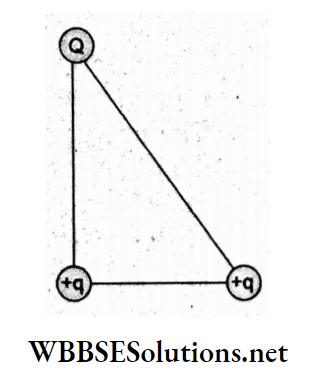
- +q
- -q
- \(\frac{-q}{1+\sqrt{2}}\)
- \(\frac{-\sqrt{2} q}{1+\sqrt{2}}\)
Answer: 4. \(\frac{-\sqrt{2} q}{1+\sqrt{2}}\)
The electrostatic potential energy of the given system of charges is
⇒ \(U=\frac{1}{4 \pi \varepsilon_0}\left(\frac{Q q}{a}+\frac{q^2}{a}+\frac{Q q}{\sqrt{2} a}\right)\)
For U to be zero, \(Q q+q^2+\frac{Q q}{\sqrt{2}}=0\)
⇒ \(Q\left(1+\frac{1}{\sqrt{2}}\right)=-q\)
⇒ \(Q=-\frac{\sqrt{2} Q}{\sqrt{2}+1}\)
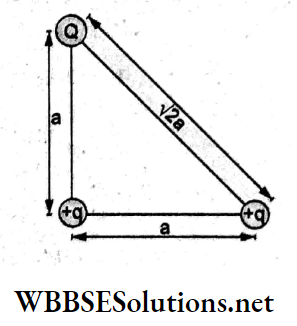
Question 96. A uniformly charged ring of radius 3a and total charge Q is placed in the xy-plane centered at the origin. A point charge q moves towards the ring along the z-axis and has speed v at z = 4a. The minimum value of v such that it crosses the origin is
- \(\sqrt{\frac{2}{m}}\left(\frac{2}{15}, \frac{q^2}{4 \pi \varepsilon_0 a}\right)^{1 / 2}\)
- \(\sqrt{\frac{2}{m}}\left(\frac{1}{15} \cdot \frac{q^2}{15 \times 4 \pi \varepsilon_0 a}\right)^{1 / 2}\)
- \(\sqrt{\frac{2}{m}}\left(\frac{1}{5} \cdot \frac{q^2}{4 \pi \varepsilon_0 a}\right)^{1 / 2}\)
- \(\sqrt{\frac{2}{m}}\left(\frac{4}{15} \cdot \frac{q^2}{4 \pi \varepsilon_0 a}\right)^{1 / 2}\)
Answer: 1. \(\sqrt{\frac{2}{m}}\left(\frac{2}{15}, \frac{q^2}{4 \pi \varepsilon_0 a}\right)^{1 / 2}\)
The minimum speed of the point charge at P should be such that it just reaches the center O of the ring. Conserving energy,
(KE)p + (PE)P = (KE)0f (PE)0.
Thus,
⇒ \(\frac{1}{2} m v^2+K \frac{q^2}{5 a}=0+\frac{K q^2}{3 a}\)
⇒ \(\frac{1}{2} m v^2=\frac{K q^2}{a}\left(\frac{1}{3}-\frac{1}{5}\right)\)
= \(\frac{1}{4 \pi \varepsilon_0} \frac{q^2}{a} \cdot \frac{2}{15}\)
⇒ \(v=\sqrt{\frac{1}{4 \pi \varepsilon_0} \frac{4 q^2}{15 m a}}=\sqrt{\frac{2}{m}}\left(\frac{2}{15} \frac{q^2}{4 \pi \varepsilon_0 a}\right)^{1 / 2}\)
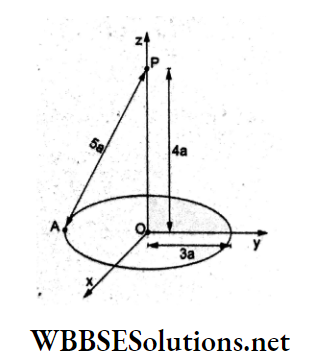
Question 97. Determine the electric dipole moment of the system of three charges placed at the vertices of an equilateral triangle, as shown in the figure.
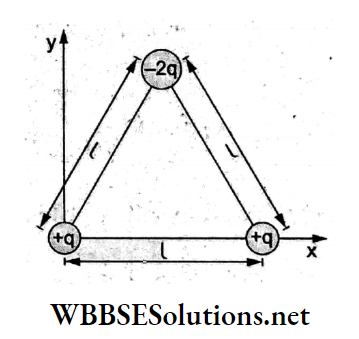
- \(\sqrt{\frac{3}{2}} q l(\hat{j}-\hat{i})\)
- \(2 q l \hat{j}\)
- \(-\sqrt{3} q l \hat{j}\)
- \(\frac{q l}{\sqrt{2}}(\hat{i}+\hat{j})\)
Answer: 3. \(-\sqrt{3} q l \hat{j}\)
The system of charges constitutes two dipoles having magnetic moments of equal magnitude (qa) inclined at 30° with the negative y-axis as shown. The cancel out and the net dipole moment becomes
⇒ \((2 p \cos \theta)(-\hat{j})=2 q l \cos 30^{\circ}(-\hat{j})=-\sqrt{3} q l \hat{j} .\)
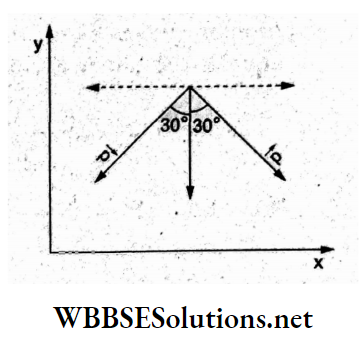
Question 98. An electric field of 1000 V m-1 is applied to an electric dipole at an angle of 45° to the dipole axis. The electric dipole moment is 10-29 C m. The potential energy of the electric dipole is
- -20 x 10-18 J
- -7 x 10-27 J
- -10 x 10-29 J
- -9 x 10-20 J
Answer: 2. -7 x 10-27 J
The potential energy of an electric dipole in a uniform electric field (E) is given by
⇒ \(U=-\vec{p} \cdot \vec{E}=-p E \cos \theta\)
⇒ \(-\left(10^{-29} \mathrm{Cm}\right)\left(10^3 \mathrm{~V} \mathrm{~m}^{-1}\right)\left(\cos 45^{\circ}\right)\)
⇒ \(-\frac{1}{\sqrt{2}} 10^{-26} \mathrm{~J}\)
= \(-7 \times 10^{-27} \mathrm{~J}\)
Question 99. The system of charges +q and -q shows an electric dipole with the midpoint at O and length AB = la. OP is perpendicular to AB. A charge Q is placed at P, where OP -y and y >> 2a. The charge Q experiences an electrostatic force F. If Q is moved along the equatorial line to P’ such that OP’ = \(\frac{y}{3}\)the force on Q will be close to (assuming \(\frac{y}{3}\) >> 2a)
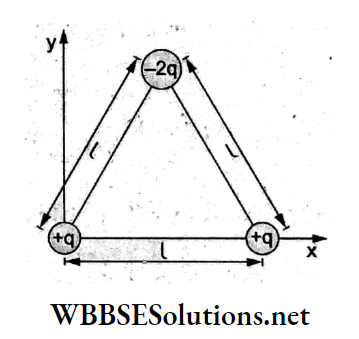
- \(\frac{F}{3}\)
- 3F
- 9F
- 27F
Answer: 4. 27F
The electric field at the equatorial point P is given by \(E=\frac{1}{4 \pi \varepsilon_0} \frac{p}{y^3}\) where OP = y.
AtP’, where OP’ = \(\frac{y}{3}\), the field
⇒ \(E^{\prime}=\frac{1}{4 \pi \varepsilon_0} \frac{p}{\left(\frac{y}{3}\right)^3}\)
⇒ \(\frac{E^{\prime}}{E}=27\)
Hence, \(\frac{F^{\prime}}{F}=\frac{Q E^{\prime}}{Q E}=27\)
=> F = 27F.
Question 100. The voltage rating of a parallel-plate capacitor is 500 V. Its dielectric can withstand a maximum electric field of 106 V m-1. The plate area is 10-4 m². What is the dielectric constant if the capacitance is 15 pF?
- 3.8
- 4.5
- 6.2
- 8.5
Answer: 4. 8.5
Since E = \(\frac{V}{d}\), the separation between the plates is
⇒ \(d=\frac{V}{E}\)
= [\(\frac{500 \mathrm{~V}}{10^6 \mathrm{Vm}^{-1}}\)
= \(\frac{1}{2000} \mathrm{~m}\)
Capacitance = \(C=\frac{K \varepsilon_0 A}{d}\)
Hence the dielectric constant is
⇒ \(k=-\frac{c \cdot d}{\varepsilon_0 A}\)
= \(\frac{\left(15 \times 10^{-12} \mathrm{~F}\right)\left(\frac{1}{2000} \mathrm{~m}\right)}{\left(8.86 \times 10^{-12} \mathrm{Fm}^{-1}\right)\left(10^{-4} \mathrm{~m}^2\right)}\)
= 8.5.
Question 101. A point dipole \(\vec{p}=-p_0 \hat{x}\) is kept at the origin. The potential and electric field due to this dipole on the y-axis at a distance d are respectively,
- \(\frac{|\vec{p}|}{4 \pi \varepsilon_0 d^2} \text { and } \frac{-\vec{p}}{4 \pi \varepsilon_0 d^2}\)
- \(\frac{|\vec{p}|}{4 \pi \varepsilon_0 d^2} \text { and } \frac{\vec{p}}{4 \pi \varepsilon_0 d^3}\)
- \(0 \text { and } \frac{-\vec{p}}{4 \pi \varepsilon_0 d^3}\)
- \(0 \text { and } \frac{\vec{p}}{4 \pi \varepsilon_0 d^3}\)
Answer: 3. \(0 \text { and } \frac{-\vec{p}}{4 \pi \varepsilon_0 d^3}\)
The potential at any point P on the equatorial line of the electric dipole is zero (0). At the same point, the electric field \(\vec{E}\) has a magnitude \(\frac{1}{4 \pi \varepsilon_0} \frac{p}{d^3}\) and direction antiparallel to \(\vec{p}\),
⇒ \(\vec{E}=\frac{1}{4 \pi \varepsilon_0}\left(\frac{-\vec{p}}{d^3}\right)\)
= \(\frac{1}{4 \pi \varepsilon_0}\left[-\left(\frac{-p_0 \hat{x}}{d^3}\right)\right]\)
⇒ \(\frac{p_0 \hat{x}}{4 \pi \varepsilon_0 d^3}=\frac{-\vec{p}}{4 \pi \varepsilon_0 d}\)
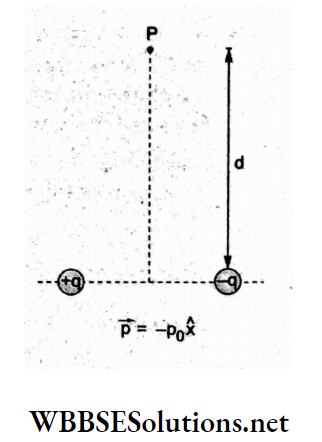
Question 102. Two electric dipoles A and B with respective dipole moment vectors \(\vec{p}_{\mathrm{A}}=4 q a \hat{i} \text { and } \vec{p}_{\mathrm{B}}=-2 q a \hat{i}\) are placed on the x-axis with a separation R as shown in the figure. The distance from Aat which both of them produce the same potential is
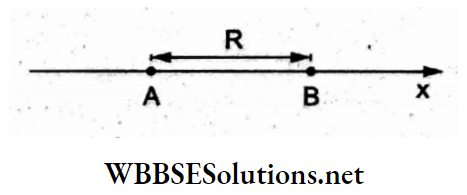
- \(\frac{\sqrt{2} R}{\sqrt{2}+1}\)
- \(\frac{\sqrt{2} R}{\sqrt{2}-1}\)
- \(\frac{R}{\sqrt{2}+1}\)
- \(\frac{R}{\sqrt{2}-1}\)
Answer: 2. \(\frac{\sqrt{2} R}{\sqrt{2}-1}\)
Let AP = x, where both the dipoles produce the same potential.
Thus, for V1 = V2, we have
⇒ \(\frac{K p_1}{x^2}=\frac{K p_2}{(R-x)^2}\)
⇒ \(\frac{2 p}{x^2}=\frac{p}{(R-x)^2}\)
⇒ \(x=\sqrt{2}(R-x)\)
⇒ \(x=\frac{\sqrt{2} R}{1+\sqrt{2}}\)
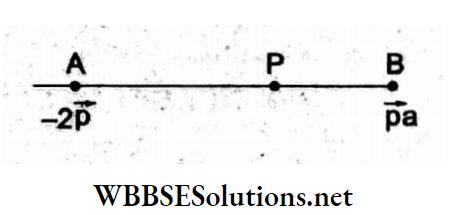
Question 103. A parallel-plate capacitor having a capacitance of 12 μF is charged by a battery to a potential difference of 10 V between its plates. The charging battery is now disconnected and a dielectric slab of dielectric constant 6.5 is inserted between the plates. The work done by the capacitor on the slab is
- 560 pJ
- 508 pJ
- 692 pJ
- 600 pJ
Answer: 2. 508 pJ
The initial electrostatic energy of the capacitor is
⇒ \(U_i=\frac{1}{2} C V^2=\frac{1}{2}\left(12 \times 10^{-12} \mathrm{~F}\right)(10 \mathrm{~V})^2\)
= 600 x 10-12J.
Disconnecting the battery will maintain the charge on the capacitor unchanged but introducing a dielectric slab will increase the capacitance.
Thus, the final energy is \(U_{\mathrm{f}}=\frac{Q^2}{2 k C}=\frac{C^2 V^2}{2 k C}=\frac{C V^2}{2 k}=\frac{600 \times 10^{-12} \mathrm{~J}}{(6.5)}\)
decrease in energy \(\Delta U=U_i-U_f=\left(600 \times 10^{-12} \mathrm{~J}\right)\left(1-\frac{1}{6.5}\right)\)
= 507.7 x 10-12J
= 508 pJ
This gives the amount of work done by the capacitor.
Question 104. A parallel-plate capacitor has a capacitance of 1 μF. One of its two plates is given a charge of +2 μC and the other plate is given a charge of +4 μC. The potential difference developed across the capacitor is
- 5 V
- 3 V
- 1 V
- 2 V
Answer: 3. 1 V
If the plates of a capacitor are H Jo, given unequal charges Q1 and Q2, the charges appearing on its four faces are as shown in the figure. The charge on the capacitor is the charge on its inner faces.
Thus, charge = \(Q=\frac{Q_1-Q_2}{2}\)
= \(\frac{4 \mu C-2 \mu C}{2}\)
= \(1 \mu C\)
∴ the potential difference across the plates of the capacitor is
⇒ \(V=\frac{Q}{C}=\frac{1 \mu \mathrm{C}}{1 \mu \mathrm{F}}\)
= 1V.
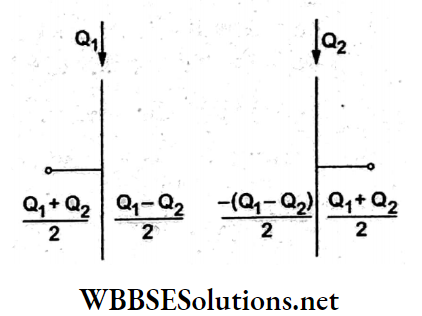
Question 105. See the given circuit diagram. After the switch S is turned from position A to B, the energy dissipated in the circuit in terms of capacitance C and total charge Q is
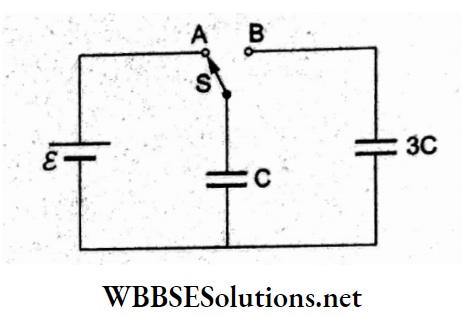
- \(\frac{5}{8} \frac{Q^2}{C}\)
- \(\frac{9}{5} \frac{Q^2}{C}\)
- \(\frac{9}{4} \frac{Q^2}{C}\)
- \(\frac{1}{8} \frac{Q^2}{C}\)
Answer: 2. \(\frac{9}{5} \frac{Q^2}{C}\)
The initial energy associated with C is \(U_i=\frac{1}{2} C \mathcal{E}^2=\frac{Q^2}{2 C}\)
When the switch is turned to B, there is a charge redistribution with the total charge Q remaining the same. Thus, the final energy is
⇒ \(U_{\mathrm{f}}=\frac{1}{2} \frac{Q^2}{C_{\mathrm{eq}}}=\frac{Q^2}{2(C+3 C)}=\frac{Q^2}{8 C}\)
∴ dissipated energy = \(\Delta U=U_{\mathrm{i}}-U_{\mathrm{f}}=\frac{3}{8} \frac{Q^2}{\mathrm{C}}\)
Question 106. A parallel-plate capacitor has an area of 6 cm² and a separation of 3 mm. The space between the plates is filled with three dielectric materials of equal thickness (see figure) with dielectric constants K1 = 10, K2 = 12, and K3 = 14. The dielectric constant of the material which gives the same capacitance when fully inserted in the above capacitor would be
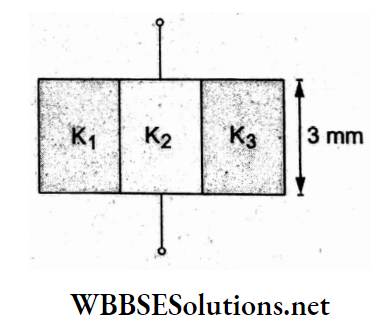
- 4
- 36
- 12
- 14
Answer: 3. 12
The combination forms three capacitors in parallel. Hence, the equivalent capacitance is
⇒ \(C=C_1+C_2+C_3=\frac{\varepsilon_0 A}{d}\left(K_1+K_2+K_3\right)\)
⇒ \(\frac{\varepsilon_0 A}{d}(10+12+14)\)
= \(36 \frac{\varepsilon_0 A}{d}\)
With a single dielectric of dielectric constant K, we get the same capacitance.
Hence, \(\frac{K \varepsilon_0(3 A)}{d}=36 \frac{\varepsilon_0 A}{d}\)
K = 12.
Question 107. In the file given the combination of capacitors, find the value of C if the effective capacitance of the whole Circuit across AB is to be 0.5 pF. All values in the circuit are in pF.
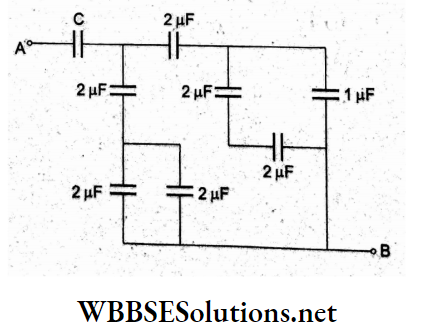
- \(\frac{6}{5} \mu \mathrm{F}\)
- \(\frac{7}{10} \mu \mathrm{F}\)
- \(\frac{7}{11} \mu \mathrm{F}\)
- \(\frac{3}{2} \mu \mathrm{F}\)
Answer: 3. \(\frac{7}{11} \mu \mathrm{F}\)
The given combination of capacitors can be redrawn as shown.
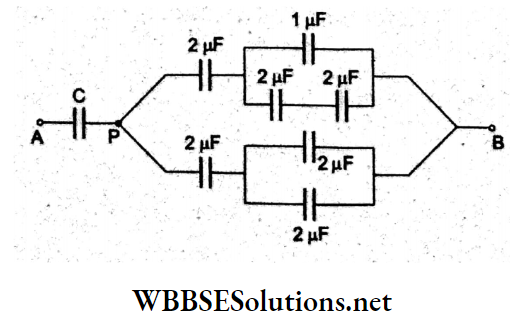
The equivalent capacitance in the upper branch across PB is
⇒ \(\frac{2 \times 2}{2+2}=1 \mu \mathrm{F}\),
and in the lower branch, it is
⇒ \(\frac{2 \times 4}{2+4}=\frac{8}{6}=\frac{4}{3} \mu \mathrm{F}\).
Hence, \(C_{\mathrm{PB}}=\left(1+\frac{4}{3}\right) \mu \mathrm{F}\)
= \(\frac{7}{3} \mu \mathrm{F}\)
Net capacitance across \(A B=\frac{C \times \frac{7}{3} \mu \mathrm{F}}{C+\frac{7}{3} \mu \mathrm{F}}=0.5 \mu \mathrm{F}=\frac{1}{2} \mu \mathrm{F}\)
⇒ \(\frac{14}{3} C=C+\frac{7}{3} \mu \mathrm{F}\)
⇒ \(\frac{11}{3} C=\frac{7}{3} \mu \mathrm{F}\)
⇒ \(C=\frac{7}{11} \mu F\)
Question 108. In the given figure the charge on the left plate of the 10-μF capacitor is -30 μC. The charge on the right plate of the 6-μF capacitor is
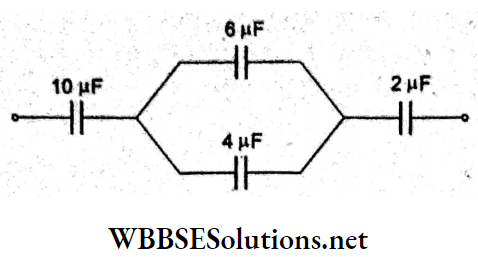
- +12 μC
- -18 μC
- -12 μC
- +18 μC
Answer: 4. +18 μC
Since the potential difference (VA – VB) is the same across both the capacitors in parallel, therefore charges are
q1 = (VA – VB) (6 μF),
and q2 = (VA-VB)(4μF).
∴ \(\frac{q_1}{q_2}=\frac{6}{4}=\frac{3}{2}\)
⇒ \(q_2=\frac{2}{3} q_1\)
Now, q1 + q2 = 30μC
⇒ \(\frac{5}{3}\)q1 = 30μC
∴ the charge on the right plate of the upper capacitor q1 = +18 μC.
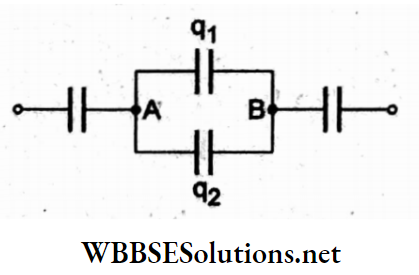
Question 109. The parallel combination of two air-filled parallel-plate capacitors of capacitance C and nC is connected to a battery of voltage V. When the capacitors are fully charged, the battery is removed and after that, a dielectric plate of dielectric constant K is inserted between the two plates of the first capacitor. The new potential difference of the combined system is
- \(\frac{V}{n+k}\)
- \(\left(\frac{n+1}{n+k}\right) V\)
- \(\left(\frac{n \cdot}{n+k}\right) V\)
- V
Answer: 2. \(\left(\frac{n+1}{n+k}\right) V\)
In the first case, let Q1 and Q2 be the charges on the capacitors.
Hence, Q1 = CV and Q2 = nCV.
∴ the total charge is Q = Q1 + Q2 = CV(n + 1)…. (1)
In the 2nd case, when the battery is removed and a dielectric plate is inserted in the first capacitor, there will be a redistribution of charge at a new PD V such that Q1 = KCV’ and Q2 = nCV’.
∴ the total charge is Q = Q1+ Q2 = C(K + n)V’…(2)
Equating (1) and (2),
C(n + K)V’ = (n + 1) CV
⇒ \(V^{\prime}=\left(\frac{n+1}{n+K}\right) V\)
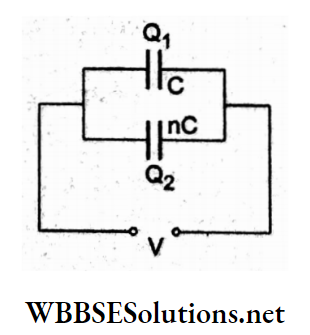
Question 110. The given figure shows the charge (q) versus voltage (V) graphs for series and parallel combinations of two given capacitors. The capacitances are
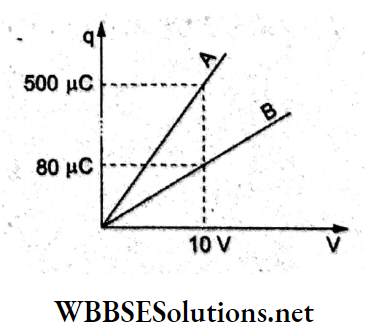
- 50 μF, 30 μF
- 60 μF, 40 μF
- 40 μF, 10 μF
- 20 μF, 30 μF
Answer: 3. 40μF, 10μF
The slope of the two lines is \(\frac{q}{v}\), which is the equivalent capacitance.
Hence,
⇒ \(C_{\text {parallel }}=\frac{500 \mu \mathrm{C}}{10 \mathrm{~V}}\)
= \(50 \mu \mathrm{F}\)
and \(C_{\text {series }}=\frac{80 \mu \mathrm{C}}{10 \mathrm{~V}}\)
= \(8 \mu \mathrm{F}\)
∴ \(C_1+C_2=50 \mu \mathrm{F} ; \frac{C_1 C_2}{C_1+C_2}\)
= 8μF.
Solving, we get C1 = 40 μF and C2 = 10 μF.
Question 111. A 5-pF capacitor is charged by a 220-V source. The source is disconnected and a 2.5-μF uncharged capacitor is connected to the charged capacitor. The heat dissipated during the process is
- \(\frac{121}{3}\) mJ
- 200 mJ
- \(\frac{1210}{5}\) mJ
- \(\frac{121}{3}\) mJ
Answer: 4. \(\frac{121}{3}\) mJ
Given: C1 = 5 μF, C2 = 2.5μF; V1 = 220 V, V2 = 0 (uncharged)
Common Fpotential = \(V=\frac{C_1 V_1+C_2 V_2}{C_1+C_2}\)
= \(\frac{5 \times 220}{7.5} \mathrm{~V}\)
= \(\frac{440}{3} \mathrm{~V}\)
Initial energy = \(U_1=\frac{1}{2} C_1 V_1^2\)
= \(\frac{1}{2}(5 \mu \mathrm{F})(220 \mathrm{~V})^2\)
Final energy = \(U_2=\frac{1}{2}\left(C_1+C_2\right) V^2\)
= \(\frac{1}{2}(7.5 \mu \mathrm{F})\left(\frac{5 \times 220}{7.5} \mathrm{~V}\right)^2\)
Heat dissipation = \(U_1-U_2=\frac{1}{2}(220 \mathrm{~V})^2\left(5-\frac{2.5}{7.5}\right) \mu \mathrm{F}\)
⇒ \(\frac{1}{2}(22,0)^2\left(5-\frac{10}{3}\right) \mu \mathrm{J}\)
= \(\frac{121}{3} \mathrm{~mJ}\)
Alternative method:
Loss of energy \(\Delta U=\frac{1}{2} \frac{C_1 C_2}{C_1+C_2}\left(V_1-V_2\right)^2\)
⇒ \(\frac{1}{2} \frac{(5 \mu \mathrm{F})(2.5 \mu \mathrm{F})}{(7.5 \mu \mathrm{F})}(220 \mathrm{~V})^2\)
⇒ \(\frac{121}{3}\)
Question 112. What is the potential across capacitors of capacitance C in the steady state? All resistors have an equal resistance of 2Ω.
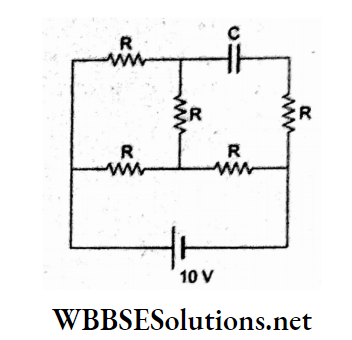
- 0 V
- 2 V
- 8 V
- 4 V
Answer: 3. 8 V
Current through the cell = l = \(\frac{10 \mathrm{~V}}{\frac{10}{3} \Omega}\) = 3A
∴ X = \(\frac{4}{6}\) x 3A = 2A, Y = l A.
The potential difference across the capacitor
V = (VA-VB) + (VB-VC)
= (2Ω)(1A) + (2Ω)(3A)
= 8 V.
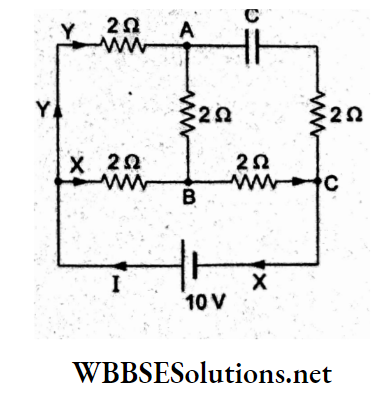
Question 113. A 20-μF capacitor is charged up to 50 V and disconnected from the source. When connected to an uncharged capacitor of unknown capacitance C, the common potential becomes 20 V. The value of C is
- 10 μF
- 20 μF
- 30 μF
- 40 μF
Answer: 3. 30μF
Given: C1 = 20 μF, C2 = C;
V1 = 50V, V2 = 0.
Common potential \(V=\frac{C_1 V_1+C_2 V_2}{C_1+C_2}\)
⇒ \(20 \mathrm{~V}=\frac{(20 \mu \mathrm{F})(50 \mathrm{~V})+C \times 0}{20 \mu \mathrm{F}+C}\)
=> 20μF + C = 50μF
=> C = 30 pF
Question 114. In the given circuit, C1 = 15μF, C3 = 8 μF, the potential difference across C3 is 20 V, and the total charge delivered by the cell is Q = 750 μC. The charge on C2 is
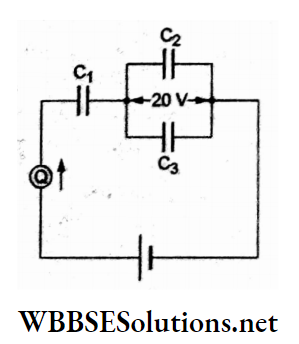
- 450μC
- 630 μC
- 160 μC
- 590 μC
Answer: 4. 590μC
Total charge = Q = Q2 + Q3
= (C2 + C3) (20 V)
=> 750 μC = (C2 + 8 μF) (20 V)
C2 = (37.5-8) μF
= 29.5 μF.
∴ the charge on C2 is Q2 = C2 (20 V)
= (29.5 μF) (20 V)
= 590μC.
Question 115. Two parallel-plate capacitors of capacitances C and 2C are respectively charged to potential differences of V and 2V between their plates. These capacitors are connected in such a way that the positive plate of one is connected to the negative plate of the other. The change in the potential energy of the system is
- 3CV²
- CV²
- \(\frac{1}{2}\)CV²
- 2CV²
Answer: 1. 3CV²
The initial energy of the capacitors is
⇒ \(U_i=\frac{1}{2} C V^2+\frac{1}{2}(2 C)(2 V)^2=\frac{9}{2} C V^2\)
When connected with polarity reversed, the common potential of the system is
⇒ \(V_{\mathrm{c}}=\frac{C V+(2 C)(-2 V)}{C+2 C}=-V\)
⇒ \(\left|V_{\mathrm{c}}\right|=V\)
The final energy of the system is
⇒ \(U_{\mathrm{f}}=\frac{1}{2} C \cdot V_{\mathrm{c}}^2+\frac{1}{2}(2 C) V_{\mathrm{c}}^2=\frac{3}{2} C V^2\)
∴ change in energy \(\Delta U=\frac{9}{2} C V^2-\frac{3}{2} C V^2\)
= \(3 C V^2\)
Question 116. A particle having a charge q is released from rest in an electric field E = E0 (1 – αx²) from the origin. Find its position when it again comes to momentary rest for the first time.
- \(\sqrt{\frac{1}{\alpha}}\)
- \(\sqrt{\frac{2}{\alpha}}\)
- \(\sqrt{\frac{3}{\alpha}}\)
- \(\sqrt{\frac{1}{2 \alpha}}\)
Answer: 3. \(\sqrt{\frac{3}{\alpha}}\)
Force = F = qE = qE0 (1- αx²).
∴ acceleration \(a=\frac{F}{m}=\frac{q E_0}{m}\left(1-\alpha x^2\right)\)
But \(a=\frac{d v}{d t}=\frac{d v}{d x} \cdot \frac{d x}{d t}=v \frac{d v}{d x}\)
⇒ \(v d v=\frac{q E_0}{m}\left(1-\alpha x^2\right) d x\)
Integrating, \(\int_0^x v d v=\frac{q E_0}{m} \int_0^x\left(1-\alpha x^2\right) d x\)
⇒ \(\frac{q E}{m}\left(x-\frac{\alpha x^3}{3}\right)=0\)
or, \(x=\sqrt{\frac{3}{\alpha}}\)
Question 117. Charge Q is distributed on two concentric spheres of radii r and R (r<R). If the charge density on both spheres is the same, the electric potential at the common center is
- \(K Q\left(\frac{1}{r}+\frac{1}{R}\right)\)
- \(\frac{k Q(r+R)}{r^2+R^2}\)
- \(\frac{k Q r R}{r+R}\)
- \(\frac{k Q\left(R^2+r^2\right)}{R+r}\)
Answer: 2. \(\frac{k Q(r+R)}{r^2+R^2}\)
Total charge = Q = q1 + q2 = 4πr²σ + 4πR²σ.
∴ surface charge density \(\sigma=\frac{Q}{4 \pi\left(r^2+R^2\right)}\)
∴ the potential at the common center is
⇒ \(V=V_1+V_2=K\left(\frac{q_1}{r}+\frac{q_2}{R}\right)\)
= K(4πrσ + 4πσR) = K4πσ (r + R)
⇒ \(\frac{K Q(r+R)}{r^2+R^2}\)
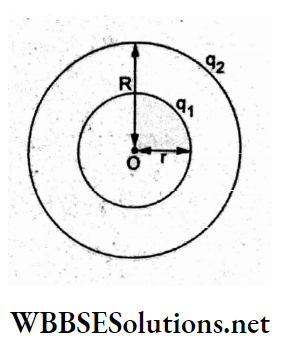
Question 118. Two concentric spherical shells of radii r and 4r are given charges Q1 and Q2 respectively. The potential difference between the shells is
- \(\frac{3}{4 \pi \varepsilon_0} \frac{Q_1}{r}\)
- \(\frac{3}{16 \pi \varepsilon_0} \frac{Q_1}{r}\)
- \(\frac{k Q r R}{r+R}\)
- \(\frac{k Q\left(R^2+r^2\right)}{R+r}\)
Answer: 2. \(\frac{3}{16 \pi \varepsilon_0} \frac{Q_1}{r}\)
Potential of the inner shell due to its own charge Q1 is \(\frac{1}{4 \pi \varepsilon_0} \frac{Q_1}{r}\) and that due to charge Qz on the outer shell is \(\frac{1}{4 \pi \varepsilon_0} \frac{Q_2}{4 r}\)
∴ the total potential of the inner shell is
⇒ \(V_1=\frac{1}{4 \pi \varepsilon_0}\left[\frac{Q_1}{\dot{r}}+\frac{Q_2}{4 r}\right]\)
Potential of the outer shell due to its own charge Q2 is \(\frac{1}{4 \pi \varepsilon_0} \frac{Q_2}{4 r}\) and that due to the inner shell (with charge Q1) is \(\frac{1}{4 \pi \varepsilon_0} \frac{Q_1}{4 r}\)
∴ the total potential of the outer shell is
⇒ \(V_{\mathrm{o}}=\frac{1}{4 \pi \varepsilon_0}\left[\frac{Q_2}{4 r}+\frac{Q_1}{4 r}\right]\)
Hence, potential difference \(V_1-V_0=\frac{1}{4 \pi \varepsilon_0}\left[\frac{Q_1}{r}-\frac{Q_1}{4 r}\right]=\frac{3}{16 \pi \varepsilon_0} \frac{Q_1}{r}\)
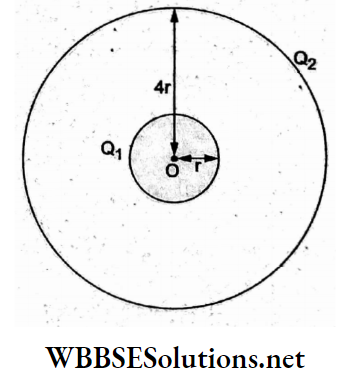
Question 119. Charges Q1 and Q2 are at points A and B of a right-angled triangle OAB. If the resultant electric field at point O is perpendicular to the hypotenuse then \(\frac{Q_1}{Q_2}\) is proportional to
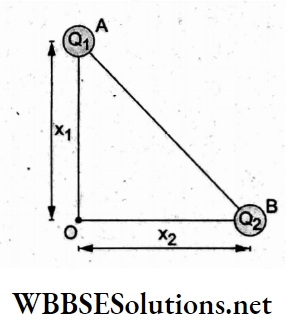
- \(\frac{x_1^2}{x_2^2}\)
- \(\frac{x_2^2}{x_1^2}\)
- \(\frac{x_2}{x_1}\)
- \(\frac{x_1}{x_2}\)
Answer: 4. \(\frac{x_1}{x_2}\)
From the given figure,
⇒ \(E_1=K \frac{Q_1}{x_1^2}, E_2=K \frac{Q_2}{x_2^2}\)
⇒ \(\frac{E_1}{E_2}=\frac{Q_1}{Q_2} \frac{x_2^2}{x_1^2}\)
But \(\frac{E_1}{E_2}=\tan \theta+\frac{x_2}{x_1}\)
From (1) and (2),
⇒ \(\frac{Q_1}{Q_2}=\frac{x_1}{x_2}\)
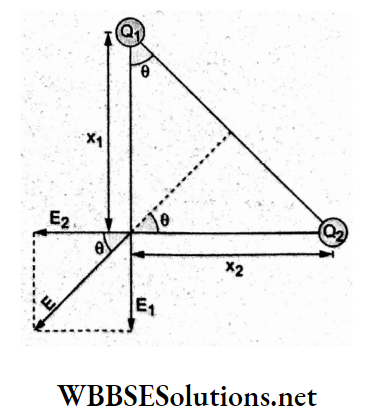
Question 120. Ten charges are placed on the circumference of a circle of radius R with constant angular separation between successive charges. Alternate charges numbered 1, 3, 5, 7, and 9 have charge +q each, while 2, 4, 6, 8, and 10 have charge -q each. The potential V and the electric field E at the center of the circle are respectively (take V = 0 at infinity)
- \(V=\frac{10 q}{4 \pi \varepsilon_0 R} \text { and } E=0\)
- V = 0; E = 0
- \(V=0 \text { and } E=-\frac{10 q}{4 \pi \varepsilon_0 R^2}\)
- \(V=\frac{10}{4 \pi \varepsilon_0 R} \text { and } E=\frac{10 q}{4 \pi \varepsilon_0 R}\)
Answer: 2. V = 0; E = 0
The potential at the center is
⇒ \(V=\frac{K q}{r}+\frac{K}{r}(-q)+\frac{K}{r}(+q) \ldots=0\)
Due to a symmetrical charge distribution, the net field at the center of symmetry is always zero.
Hence,
⇒ \(\vec{E}\) = \(\vec{0}\).
